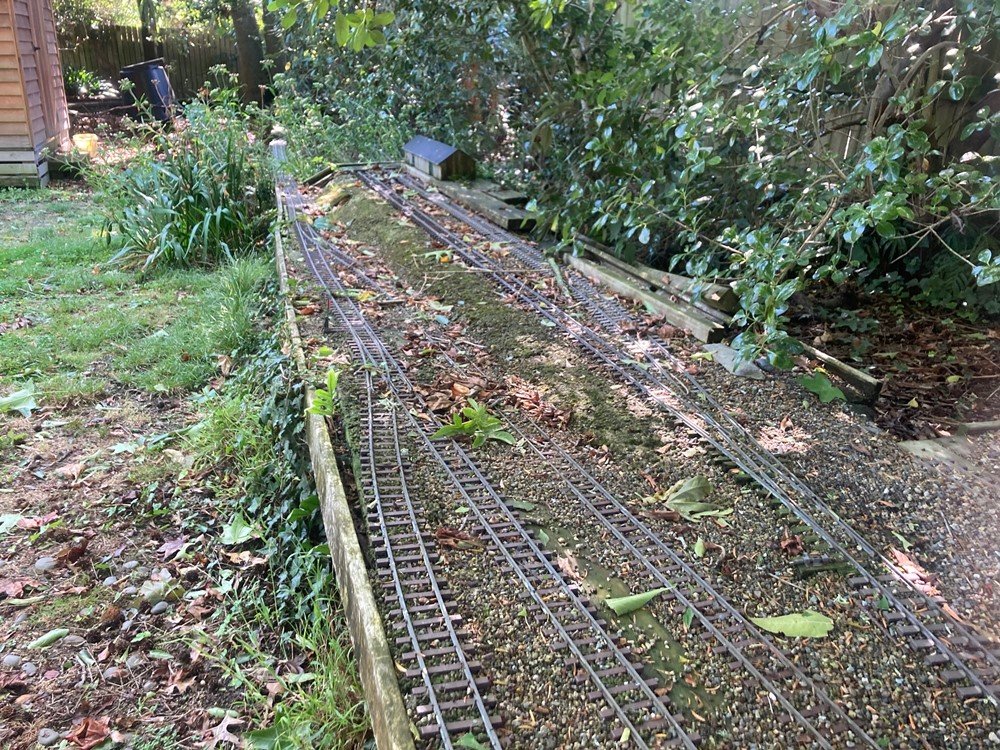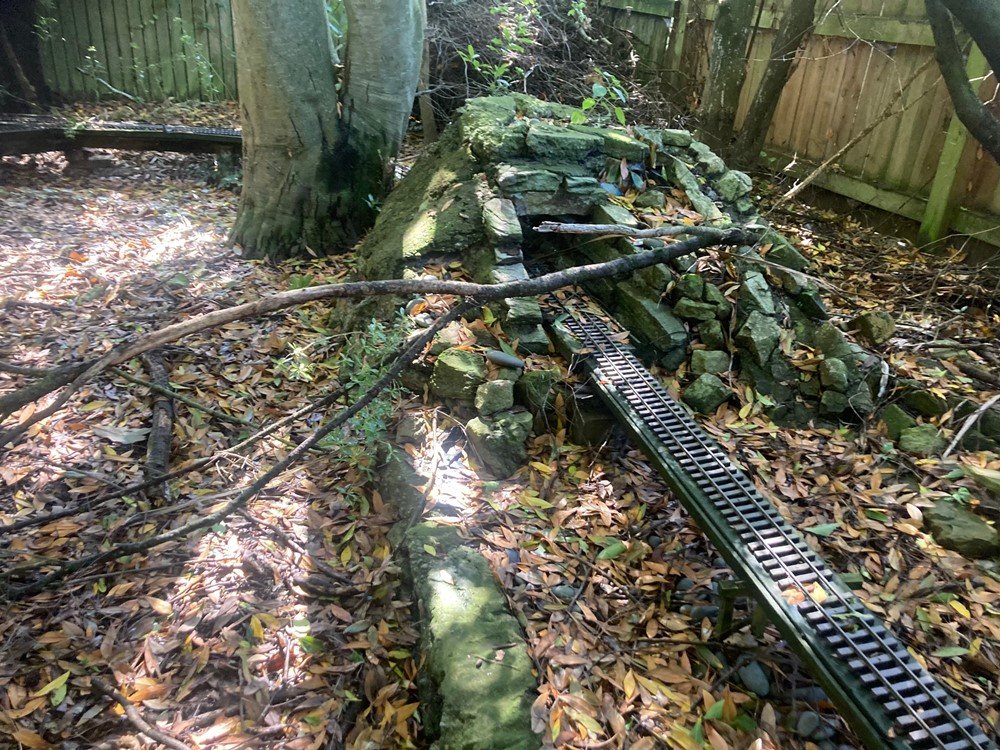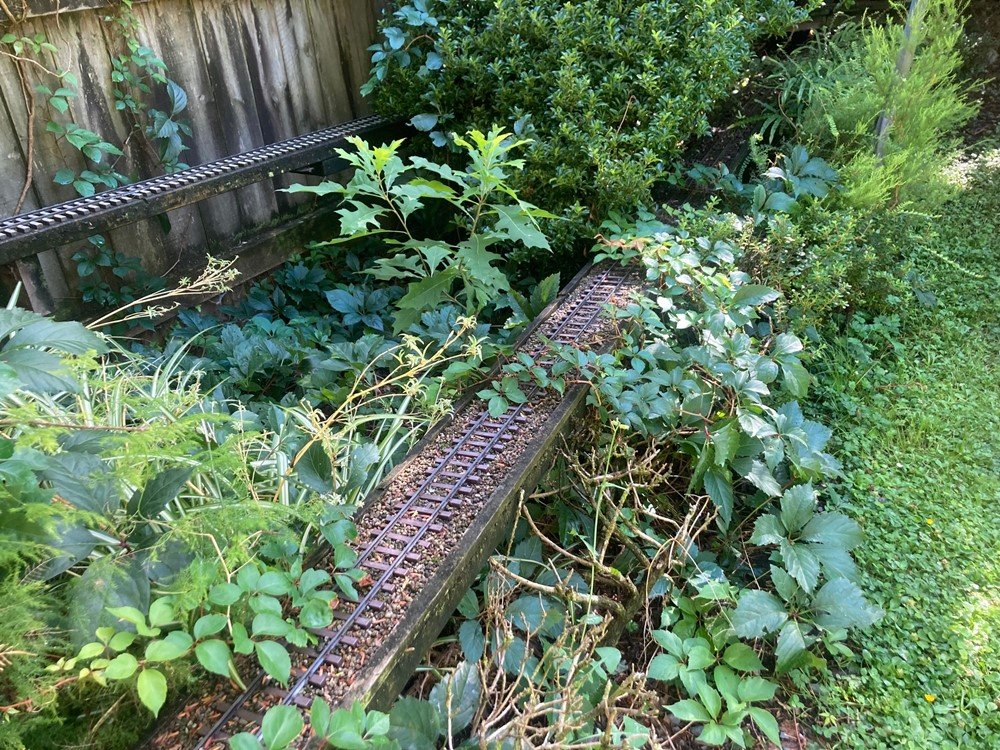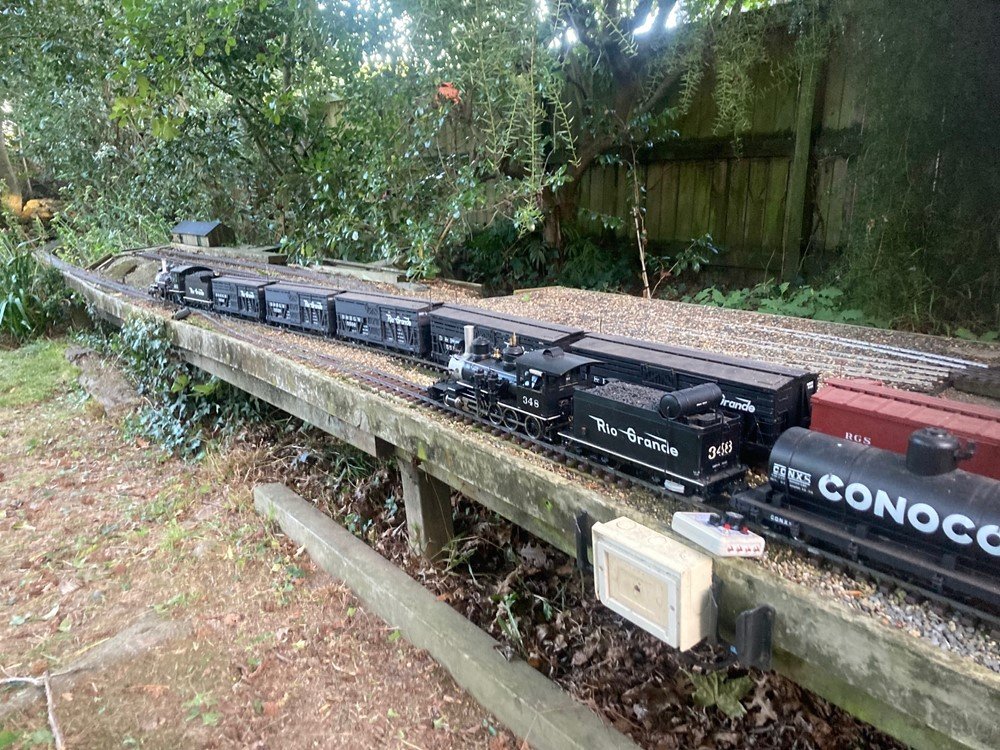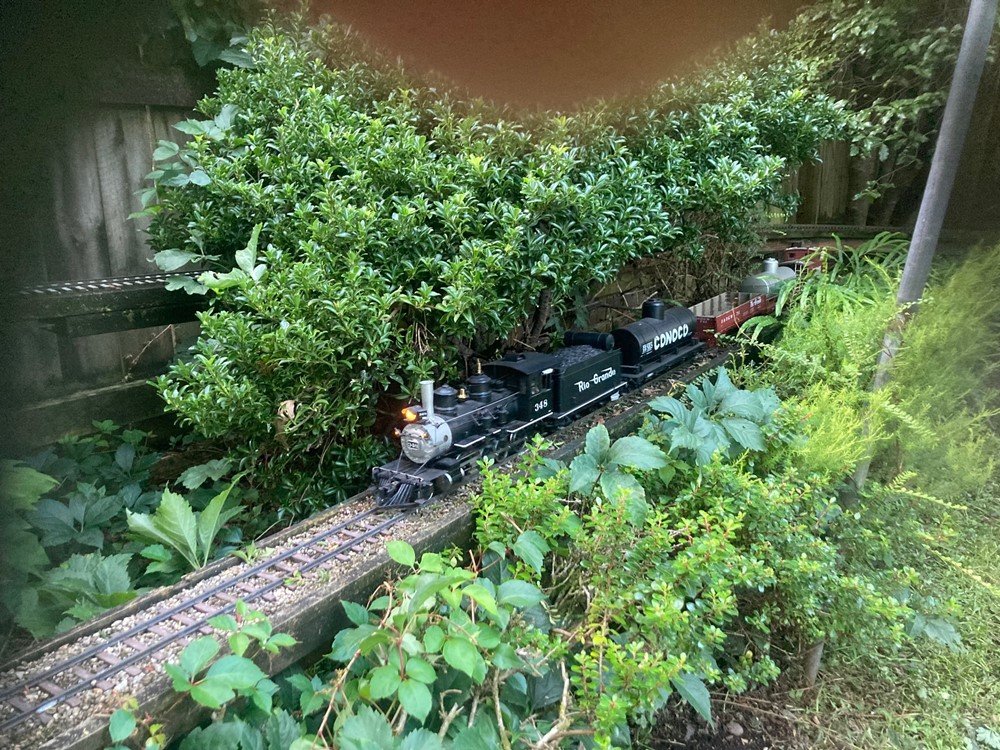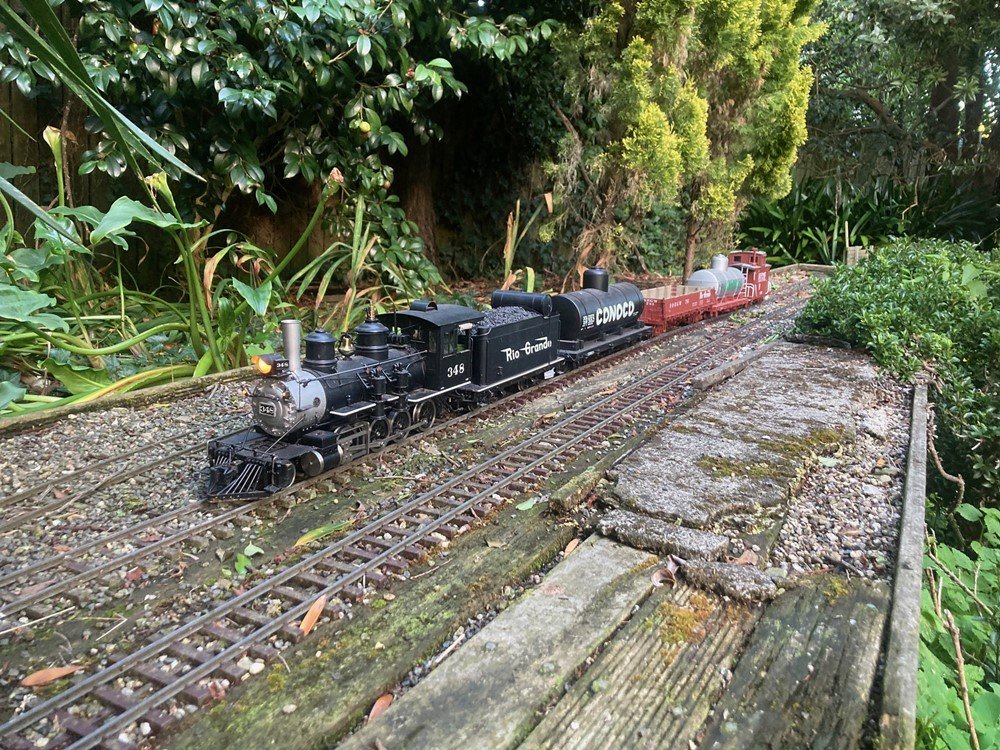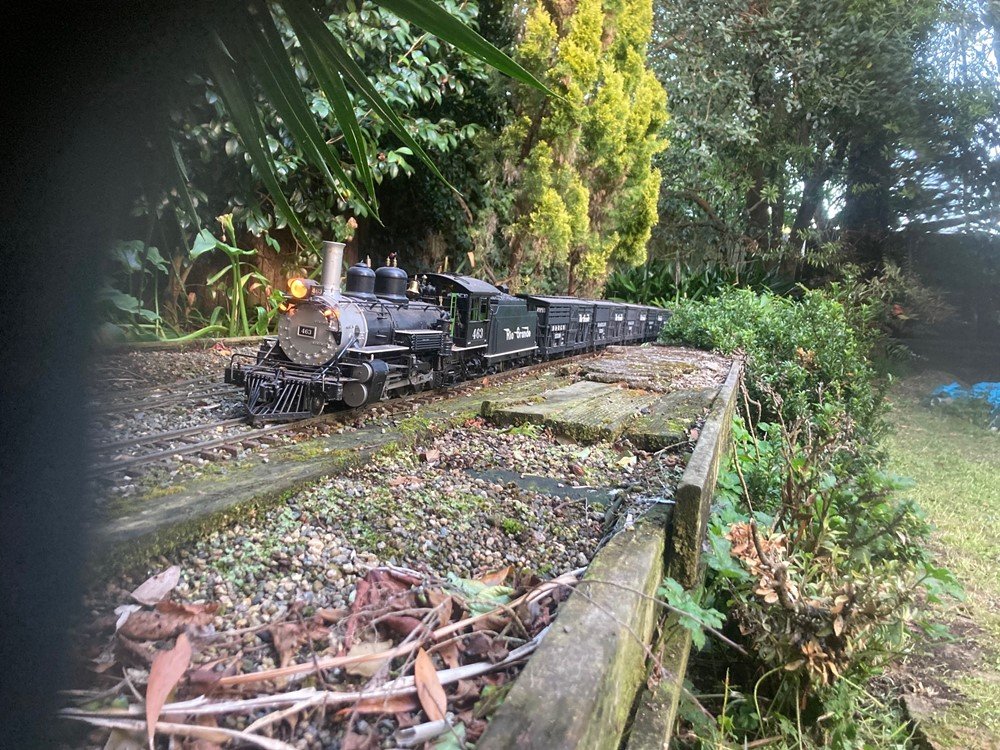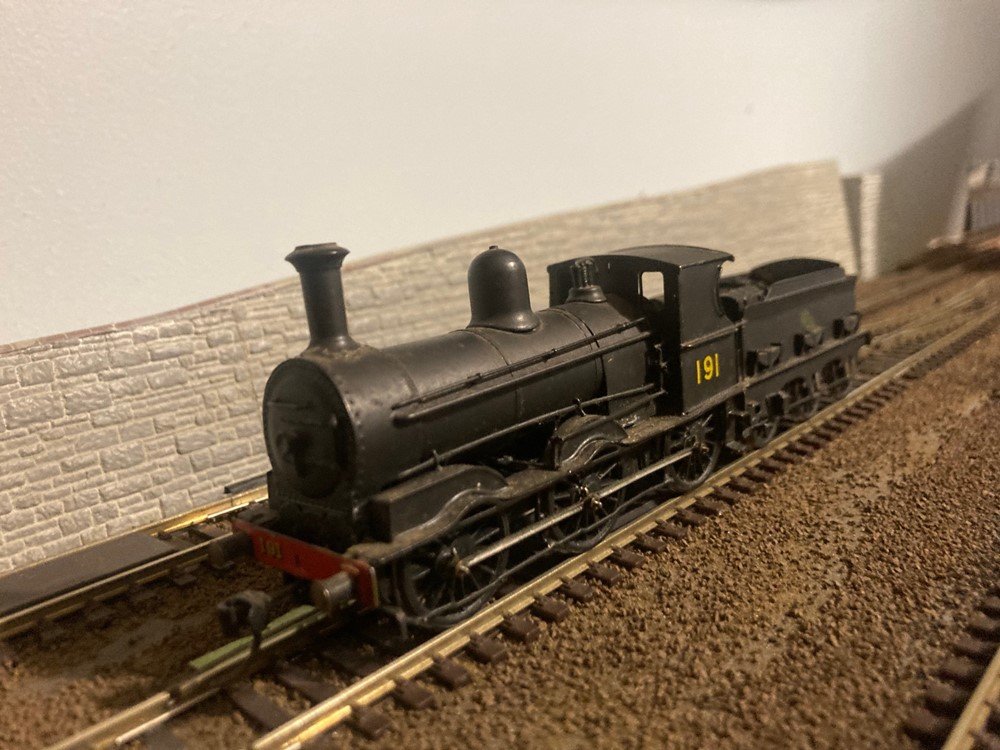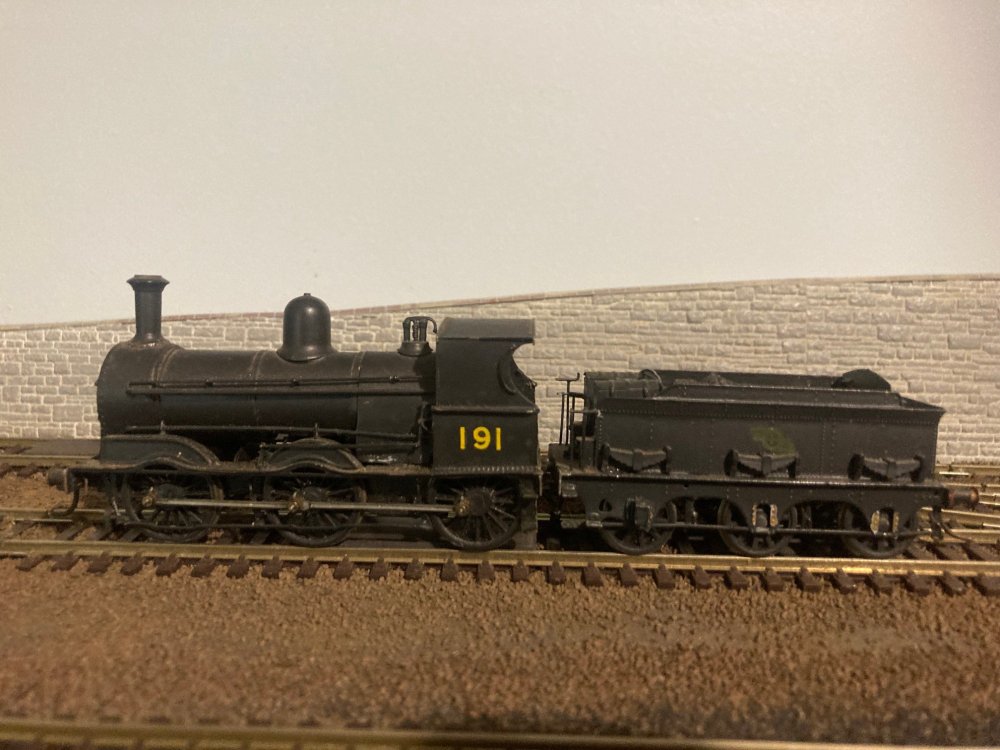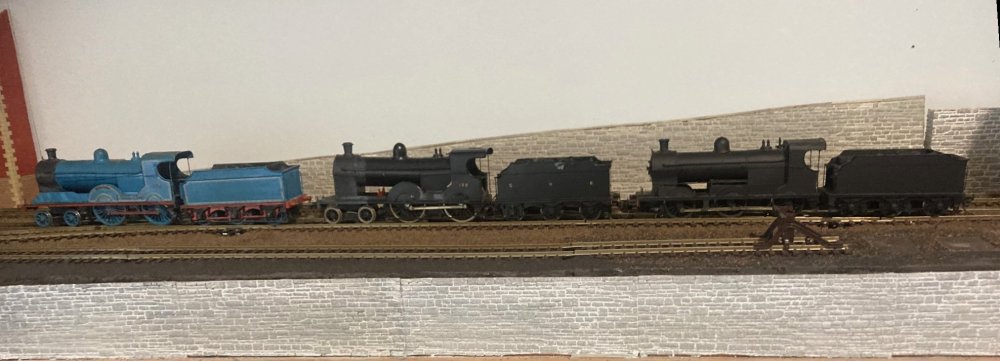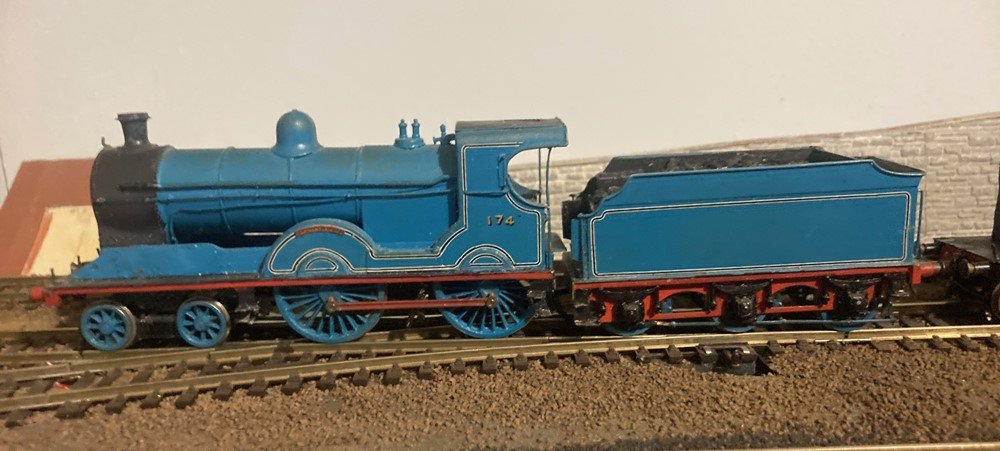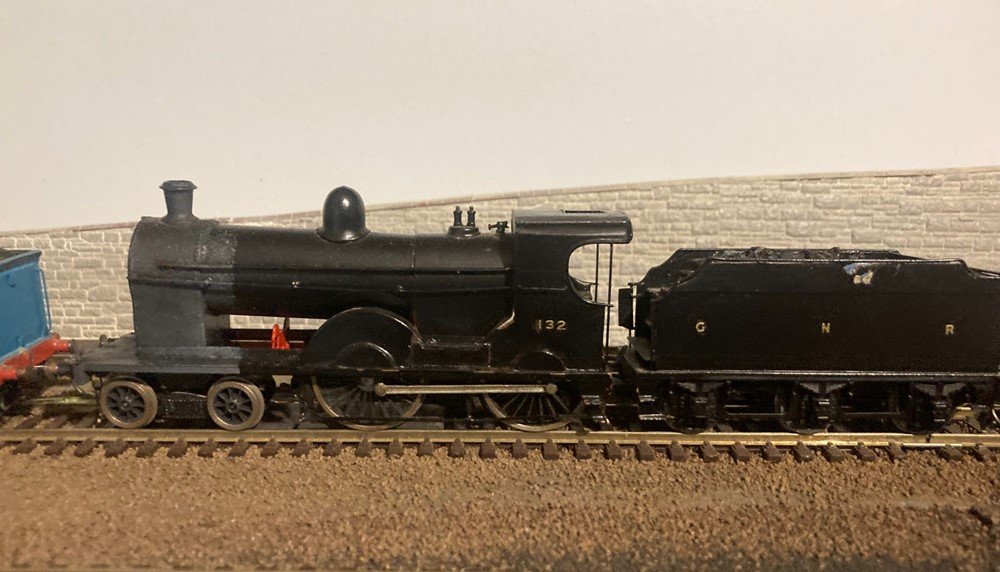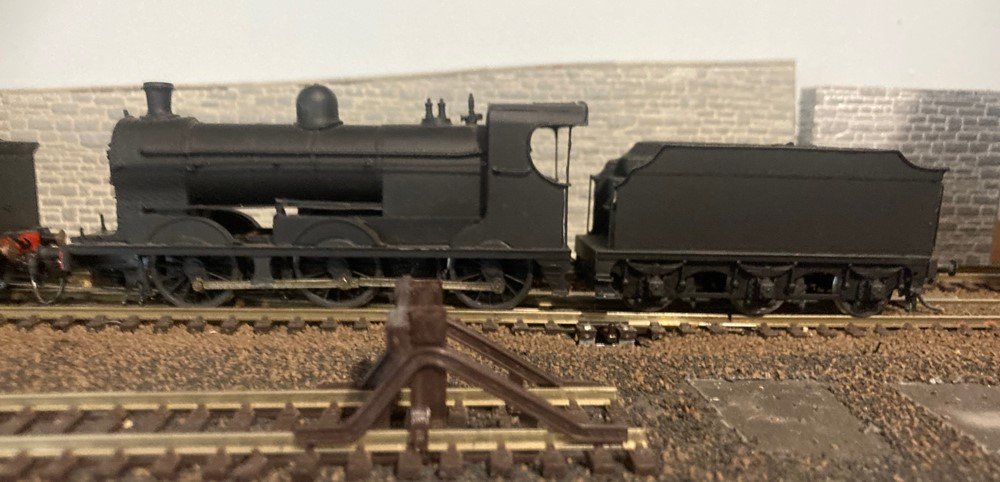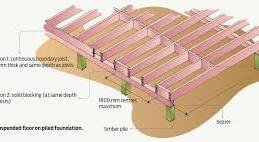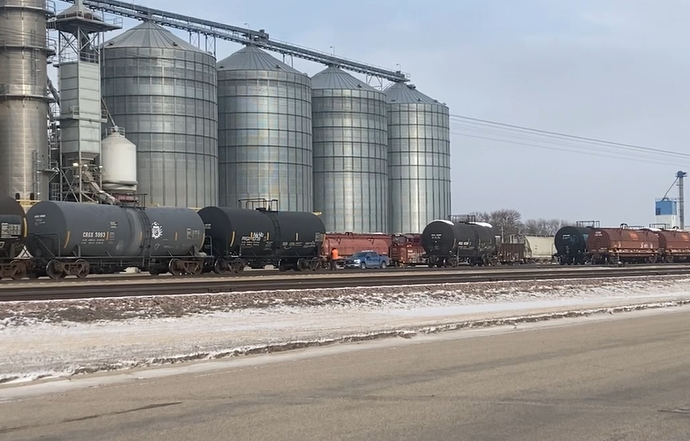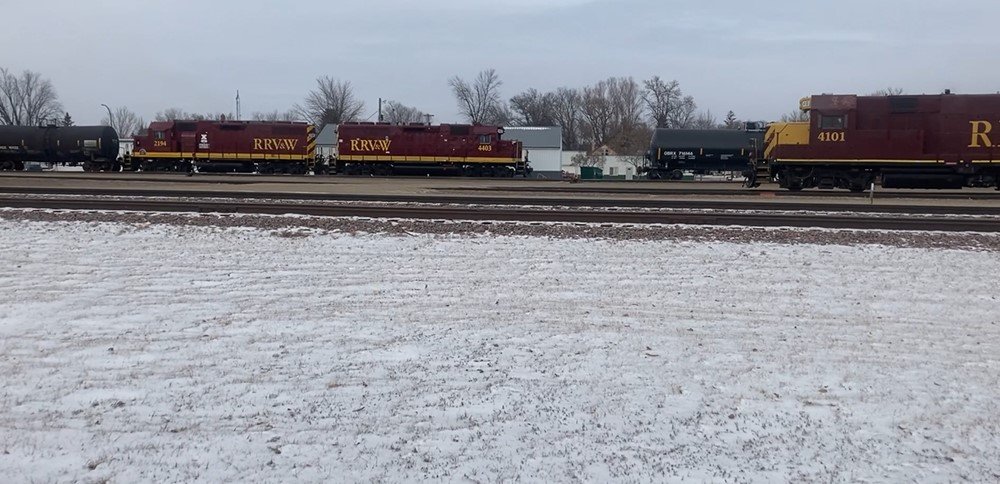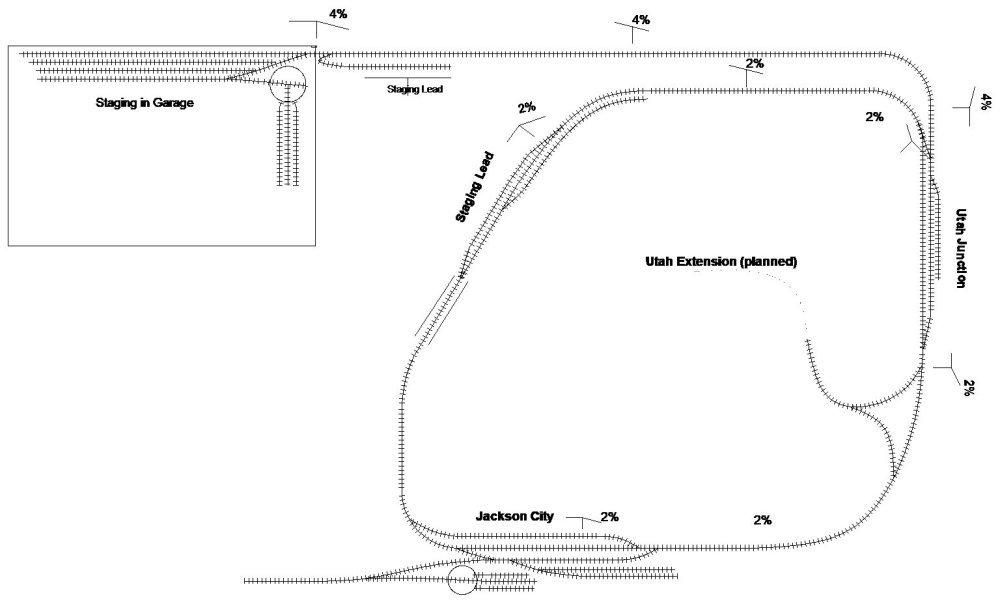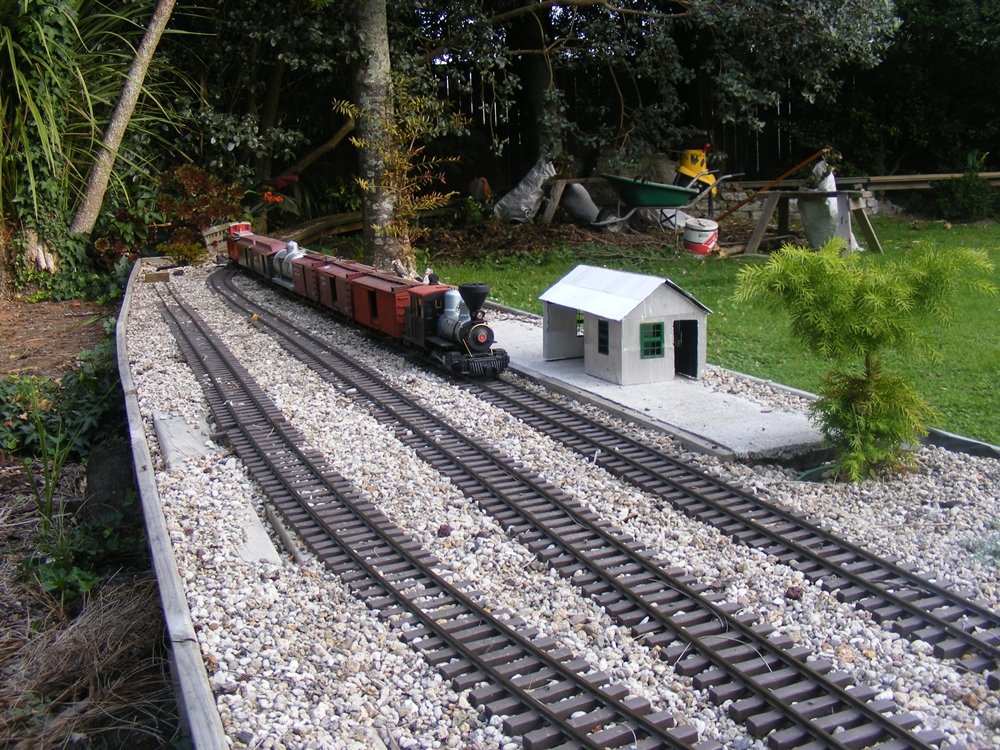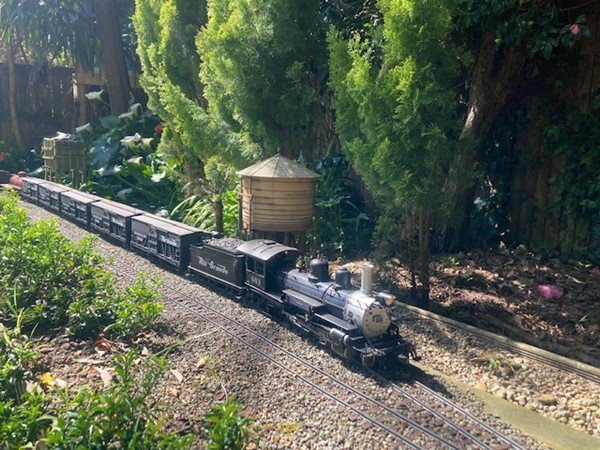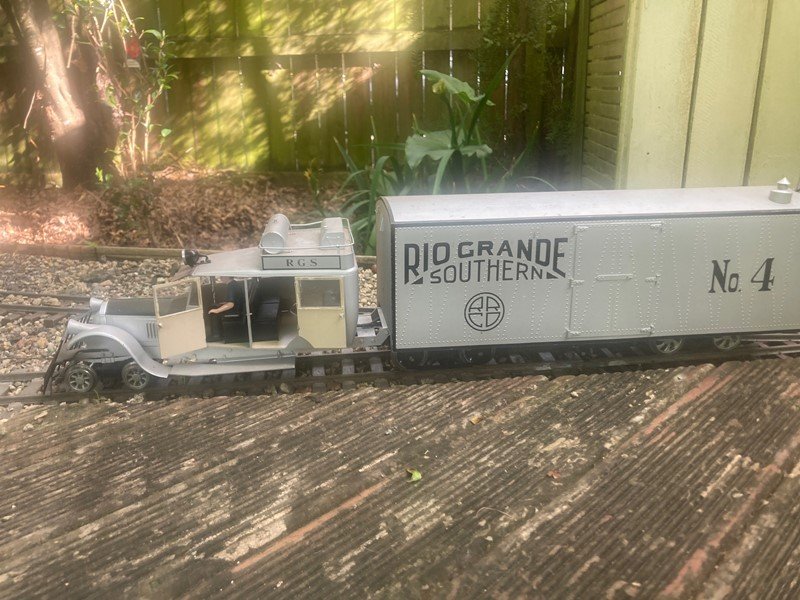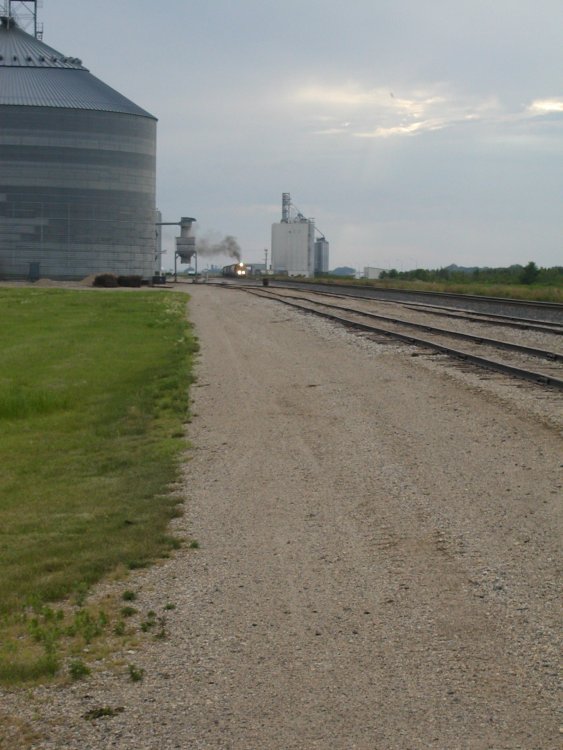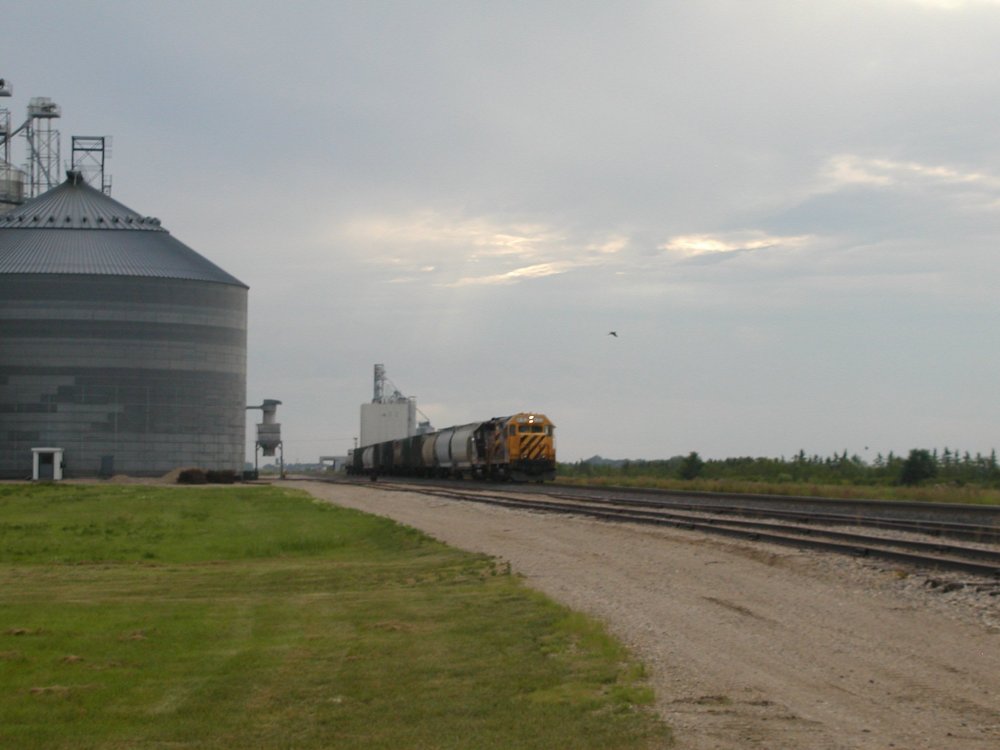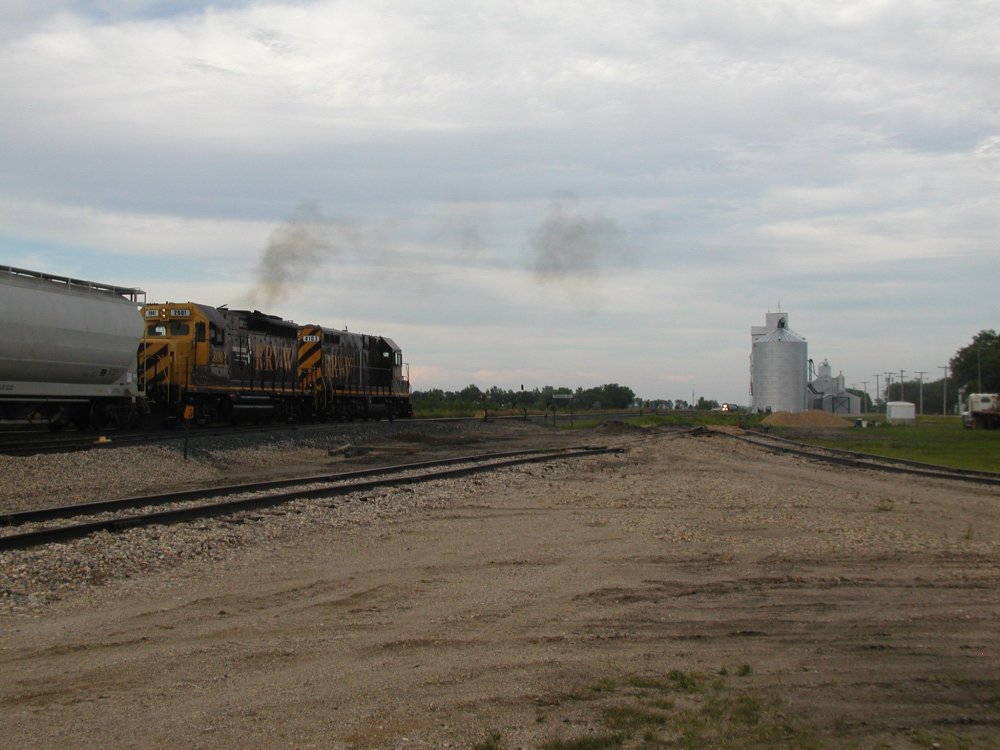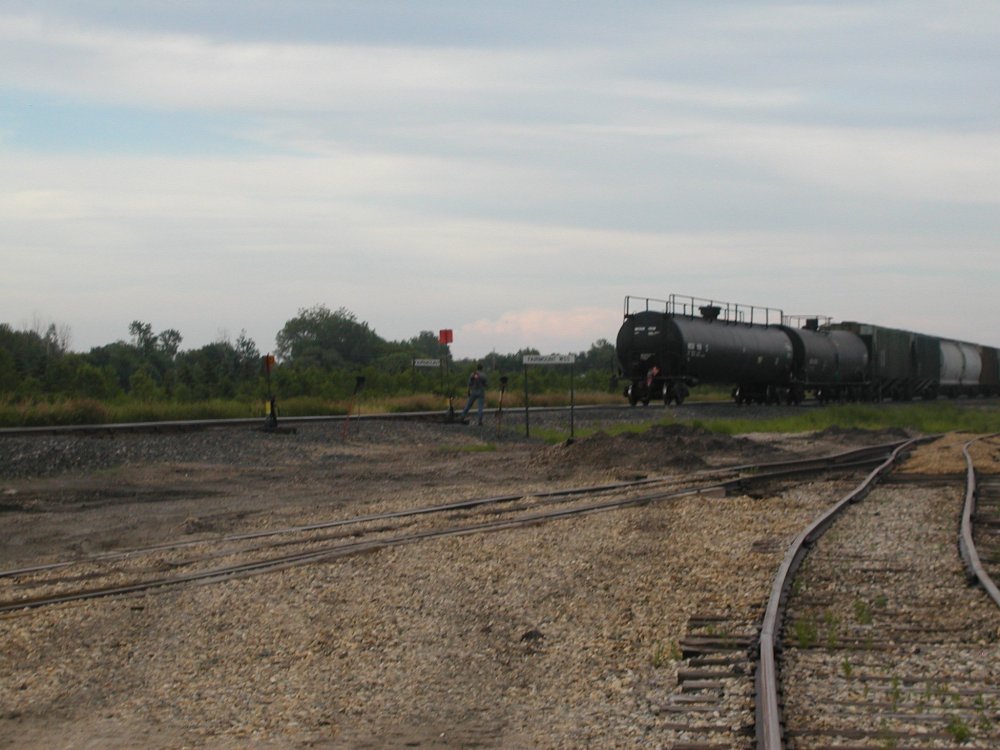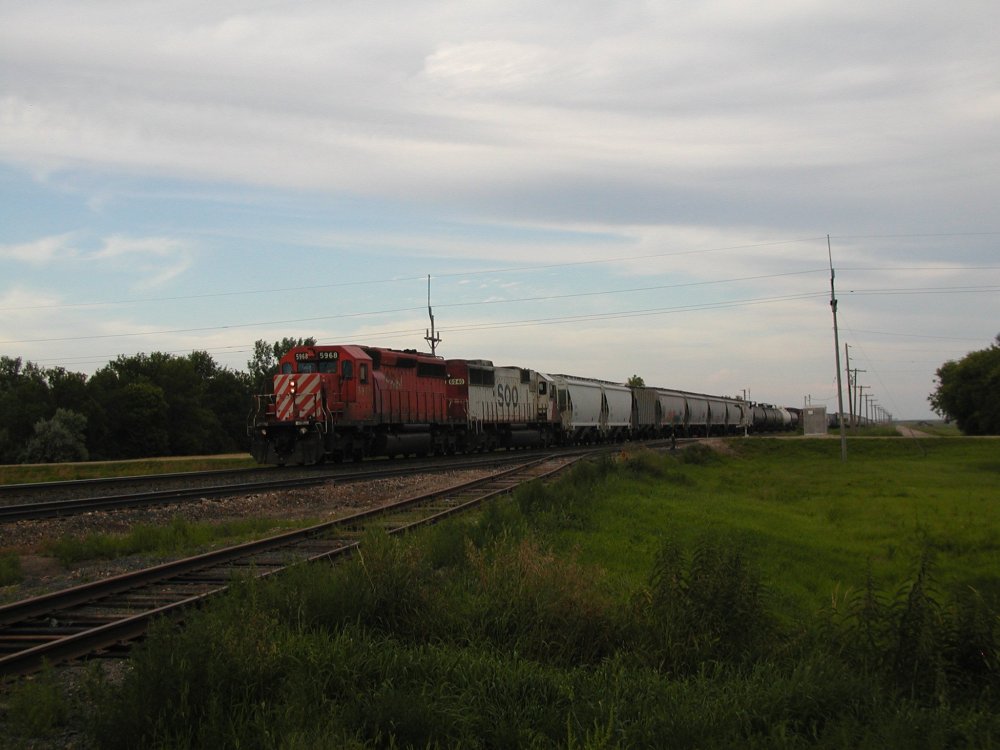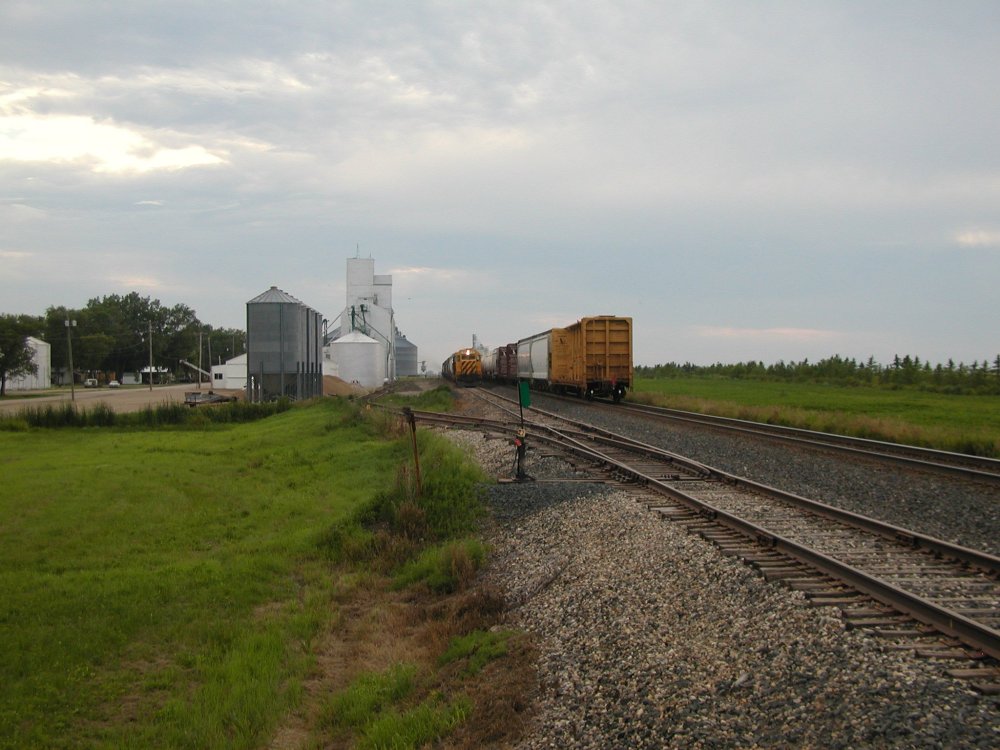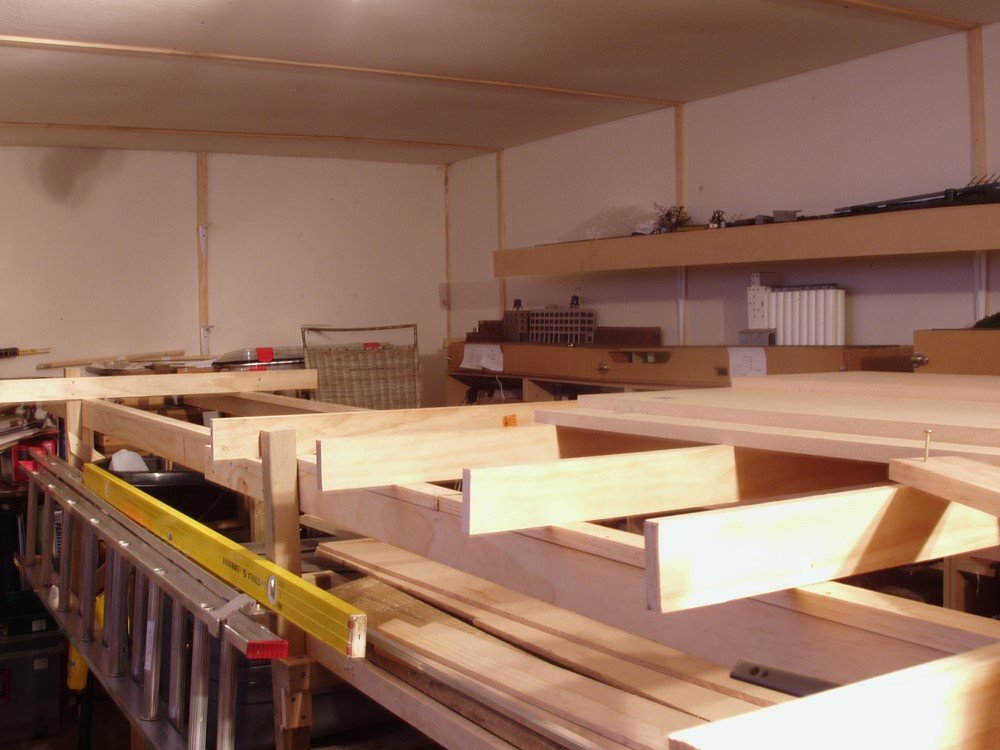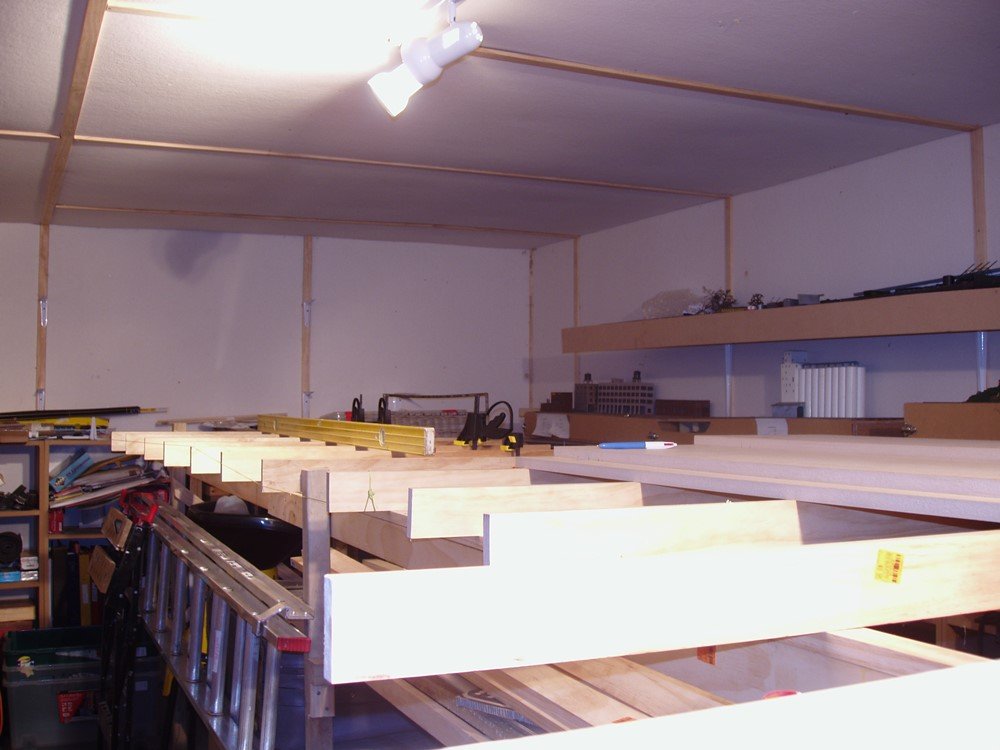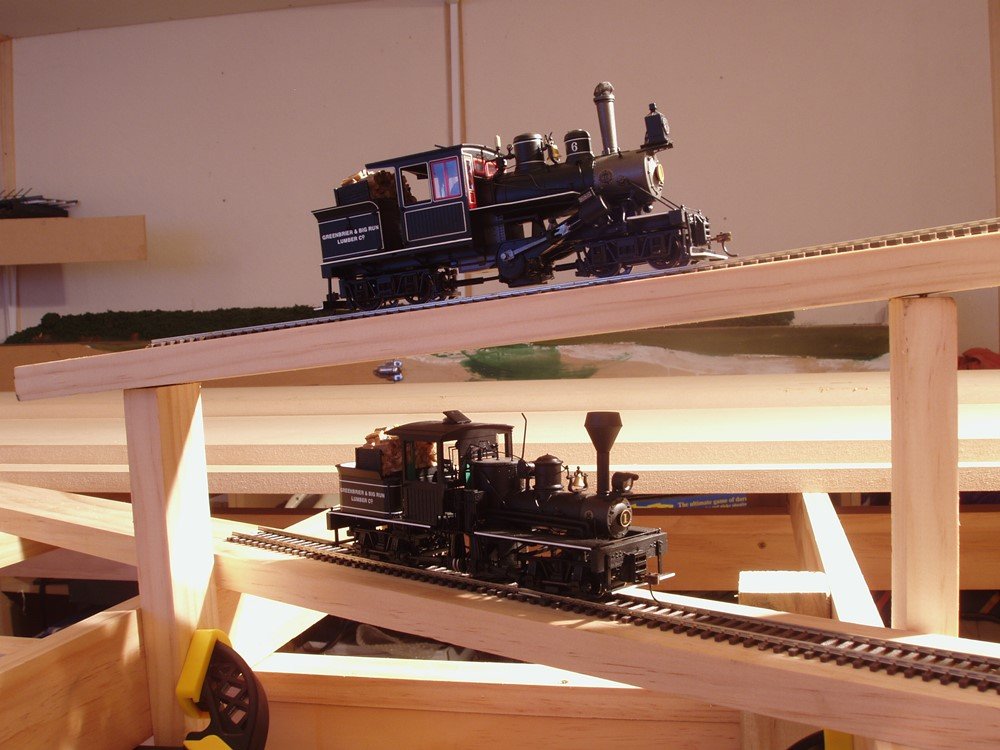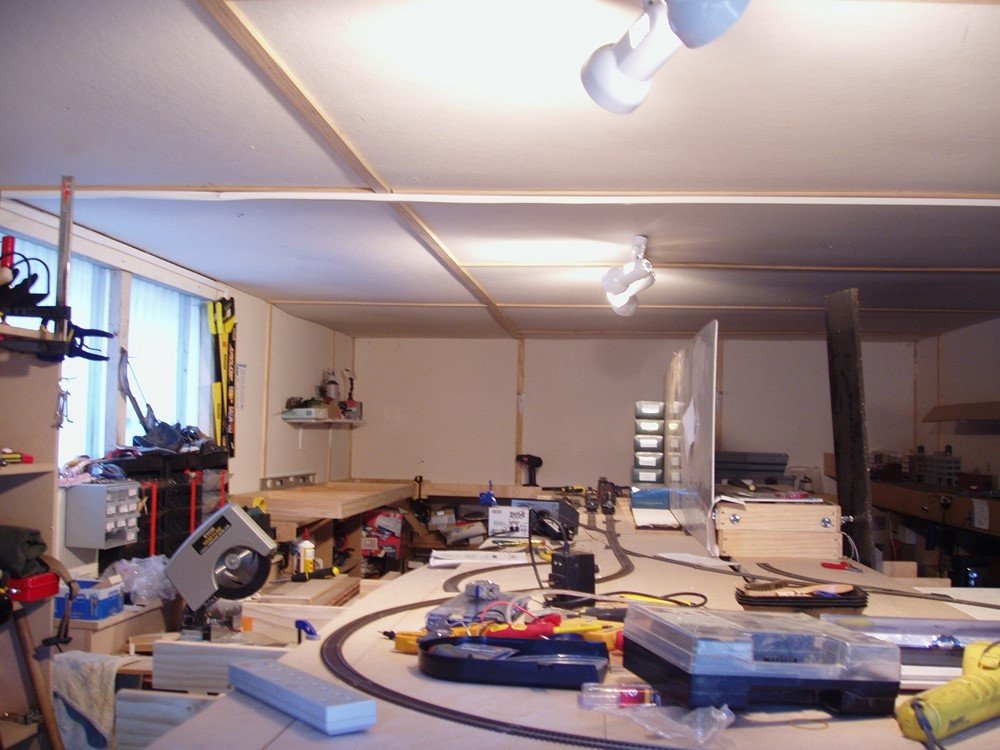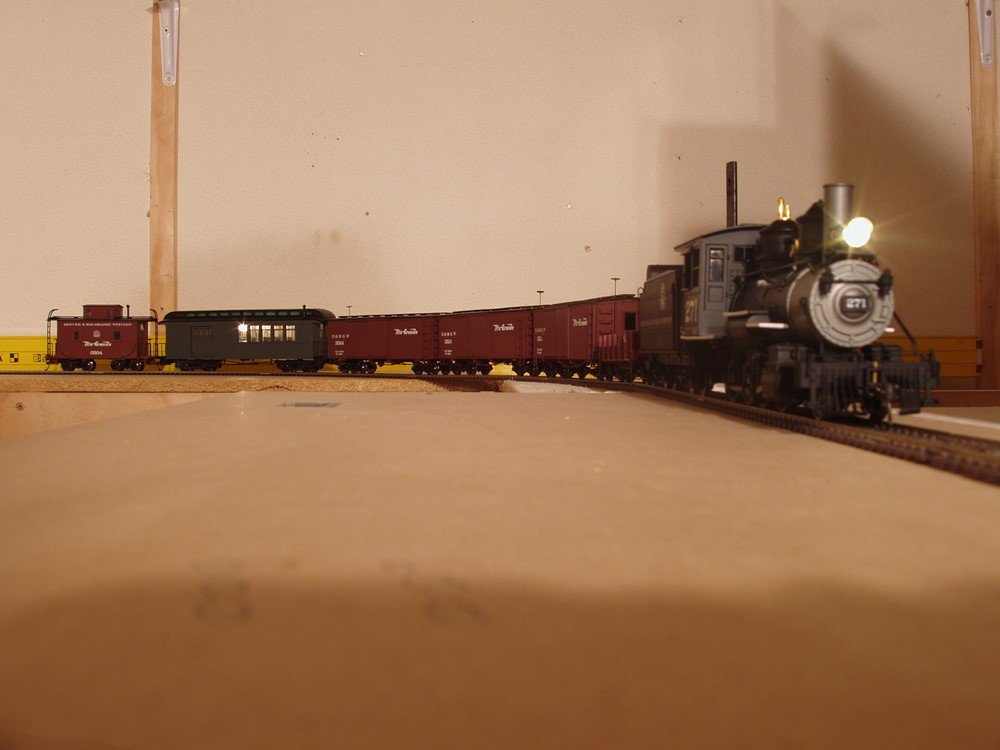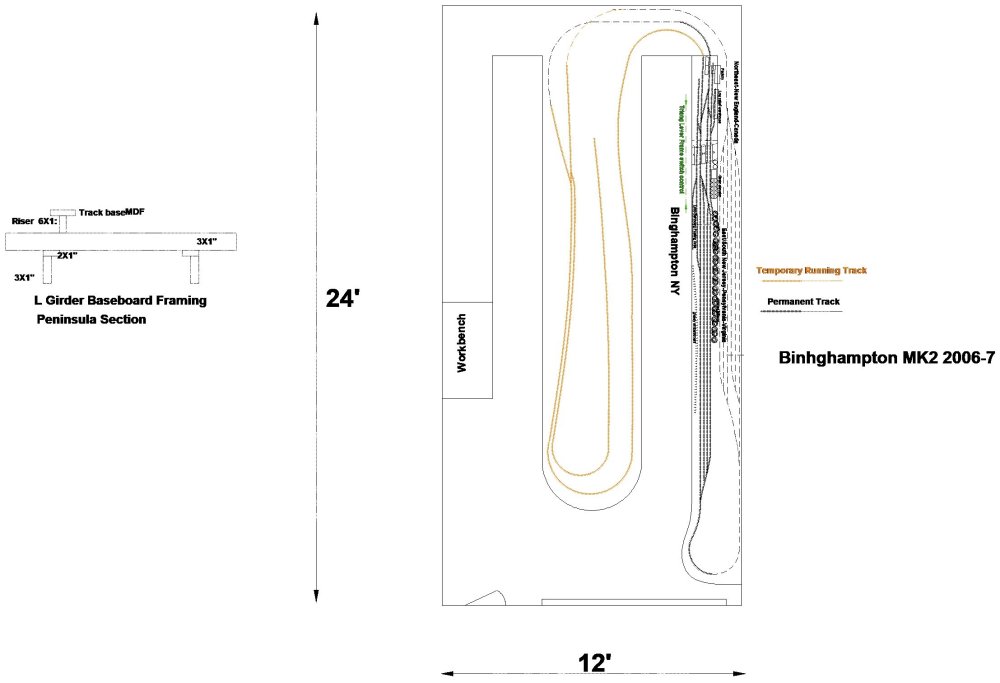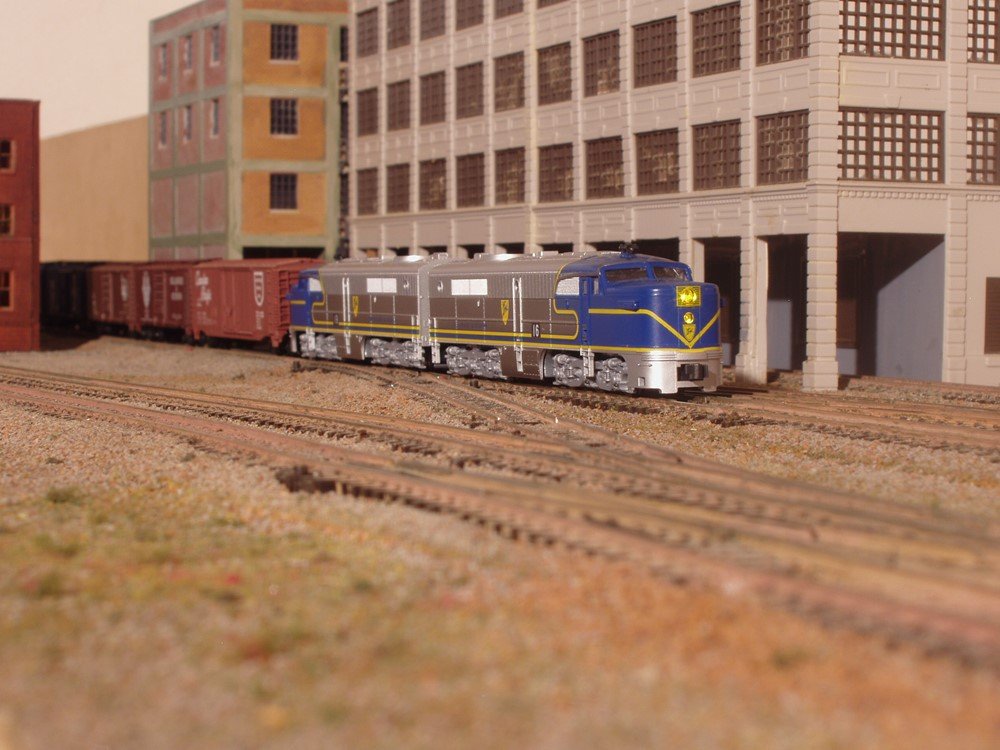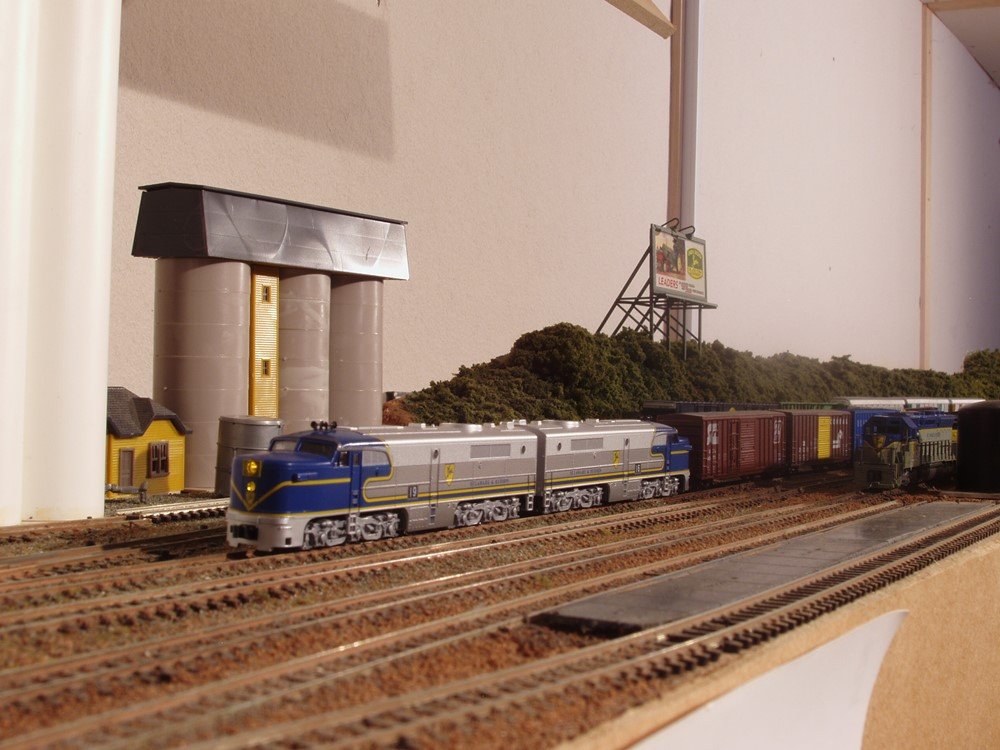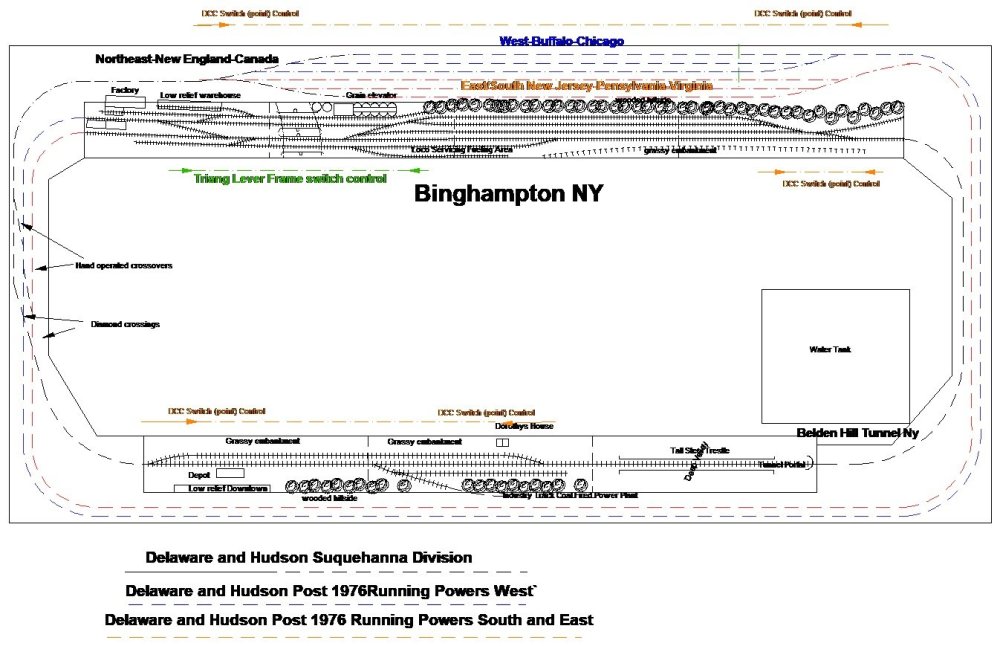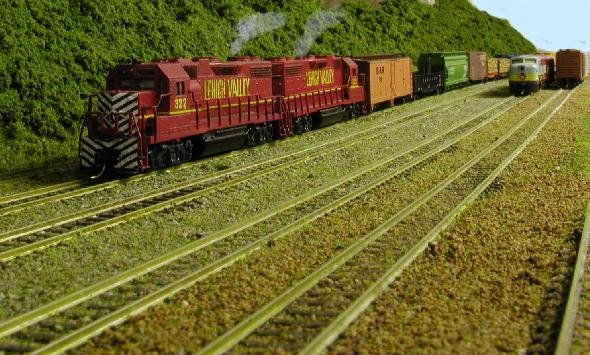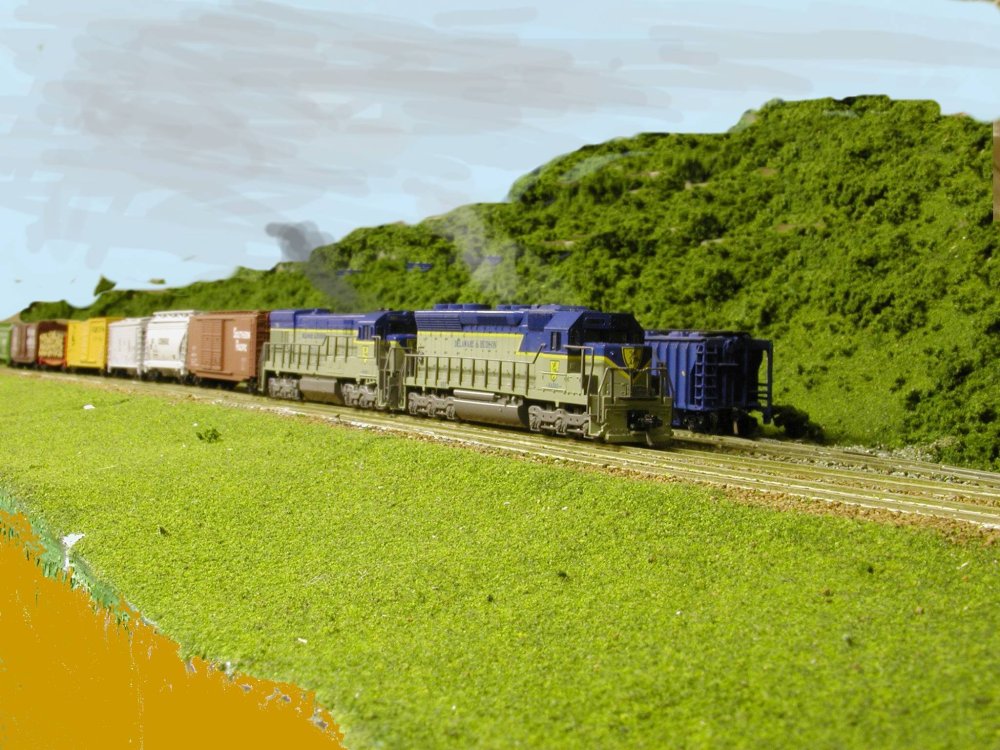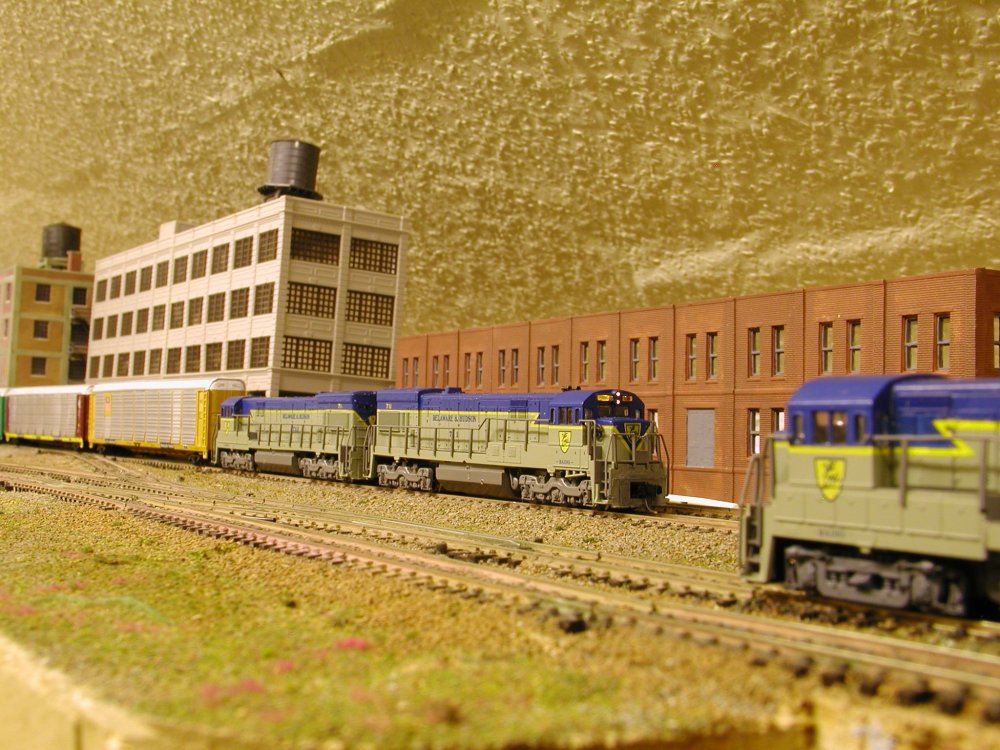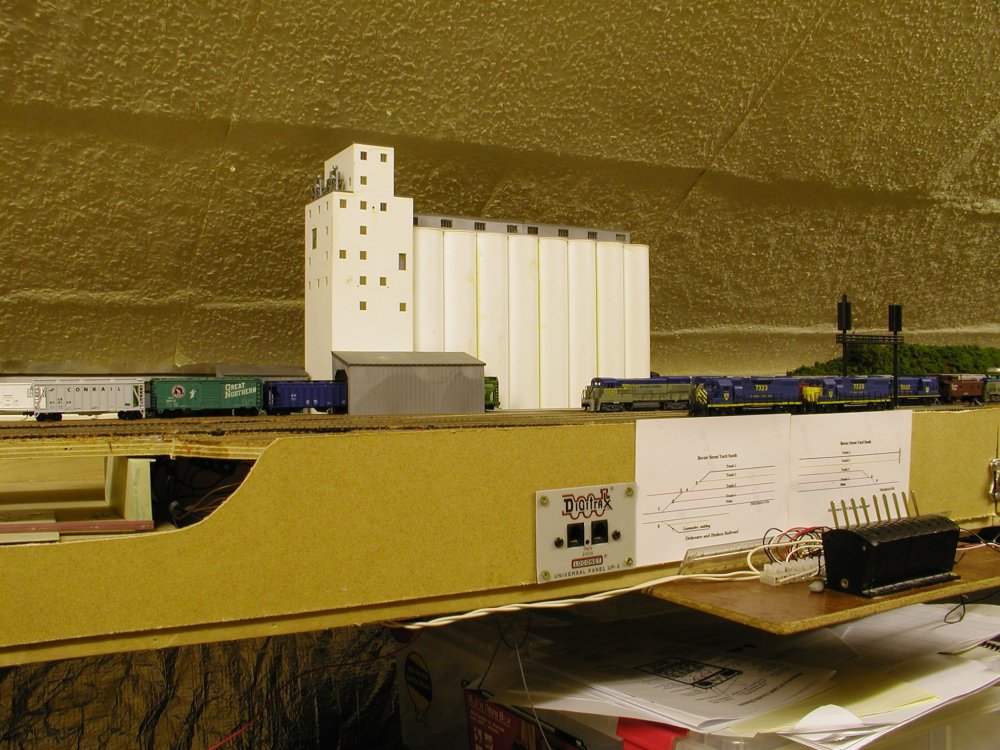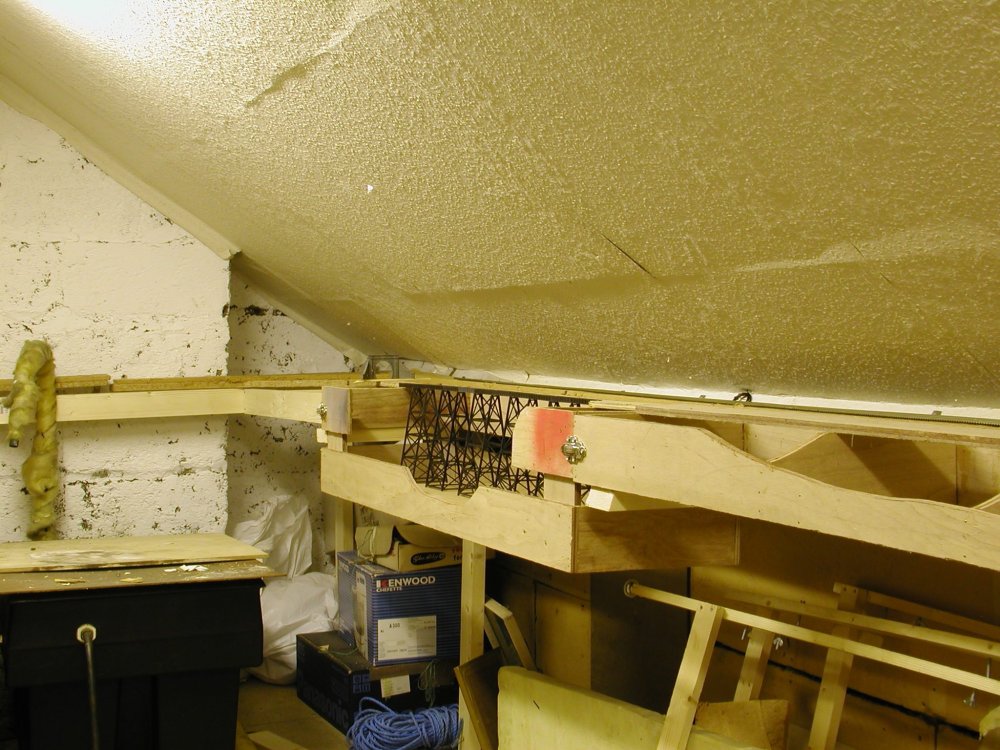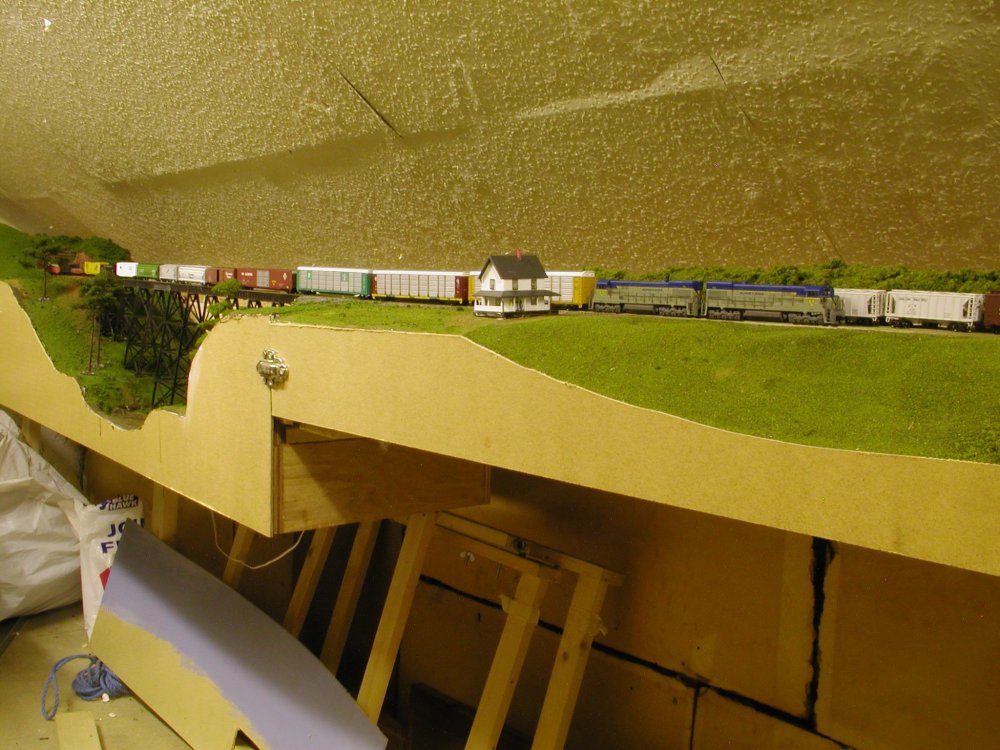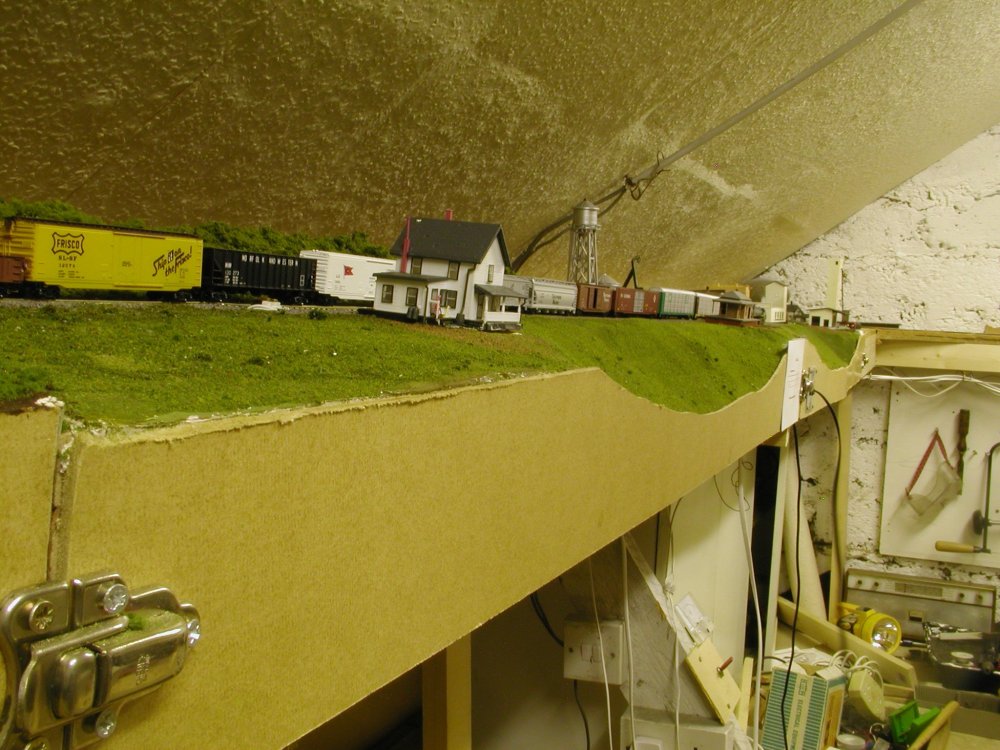-
Posts
4,879 -
Joined
-
Last visited
-
Days Won
119
Content Type
Profiles
Forums
Events
Gallery
Everything posted by Mayner
-

Would you model in 21mm if RTR track and models were readily available?
Mayner replied to BosKonay's topic in Irish Models
The UG is likely to be built from a set of Worsley Works "Scratchbuilders Parts" introduced in the early 2000. Certainly built into a fine looking model -

Narrow Gauge in the Rockies not quite
Mayner replied to Mayner's topic in US / Canadian Railway Modelling
One of the attractions of large scale modelling is coping with the elements. I lifted out a removable bridging section for some work in the garden on Monday and the rails had expanded with heat and would not fit (after 16 years) when I replaced the bridge. Ended up cutting the rails with a fine toothed piercing saw, which cut through the brass rail like a knife through butter. The blue plastic is pond-line I got cheaply as a waterproof membrane to protect the treated ply baseboard top in this area. Bridge is treated 6X2 pine. Ran 463 yesterday evening on a load test to check if there was any improvement in the hot dry weather since Sunday afternoon. 463 Stalled at the crest of the grade at Jackson City split and re-combined train to reach its destination Easy downhill part of the run! Took the train up the High Line in two sections. 463 is running at full speed in all videos! -
When it comes to sport a fairly laid back lot really: About 20 minutes devoted to sports on the 6 Oclock news. Rugby Union, Rugby League, Cricket (Black Ferns), Basket Ball (Tall Backs) Netball (White Ferns), Soccer, Rowing, Sailing, Winter Sports. Motor Racing There is an old saying that New Zealanders will support the National Team and anyone that's playing against Australia. Last year hosted Womens World Cup, hosted 12 races in 2020 Americas Cup World Series Regata 20 medals 2020 Summer Olympics---7 Gold 6 Silver 7 Bronze 5 Rowing 3 Canoeing, 2 each Rugby Sevens, Cycling and Athletics, one each Sailing, Golf, Boxing, Trampolining, Tennis and Triatlon
-
My comments were based on my experiences living and working in Ireland, Great Britain and New Zealand. Since the 60s the Irish Government has been very astute in setting up conditions (tax breaks, education system and IDA) to attract inward overseas investment which has been good for the country, the downside is that it earned Ireland the reputation of being a tax haven and unfair competition. Living in Scotland during the 90s there was a belief that Scottish Enterprise was wasting their time in attempting to compete with the IDA to attract new industry, although the NZ Government considered setting up a financial service sector during the 2100s providing similar tax breaks to Ireland was considered politically unacceptable and potentially damaging to international relations. Working in the construction sector Irish Government's policies of mortgage interest relief, home buyers grants and tax breaks to developers contributed directly to todays problems with housing affordability and high construction costs in Ireland. The ending of price control (Certificate of Reasonable Value) and the introduction of 1st time buyer grants during the 70s lead to a shift from building what we now term 'affordable homes" (3 bed terrace) to larger more expensive homes, the builders simply pocketed the £1000 1st time buyer grant (7% cost avg new home 1976) by increasing the price by £1000 and pocketing subsequent increases as the grant was increased to £4,000. The company I worked for shifted from building £14,000 to slightly smaller nos or £48,000 houses in 3 years as grants and increasing rates of mortgage relief came into effect. Developer tax breaks introduced from the late 80s onwards became were more insidious as already viable developments did not take place without a tax break, investors withdrawing their stake once they received their tax break potentially leaving the business with insufficient working capital to continue operation. I built a 150 bedroom hotel in a prominent Dublin location under one of these schemes during the late 90s, the Irish owners selling their stake upon completion. The Tralee and Blennerville appears to have been built under such a scheme, the original investors apparently able to walk away leaving Tralee Council with the liability of a disused railway when the business ran out of working capital. Over centralisation with successive Governments stripping Councils of their powers and CIEs monopoly position on surface public transport has not helped to preservation movement. In many Countries Regional and City Councils have responsibility for funding and operating public transport services and have bought and leased closed railway lines to preservation groups and private operators. The position with Youghal or Fenit Branches could have been radically different had Councils powers to acquire and operate closed railway lines. One of the lightbulb moments after settling in New Zealand was the realising that I was paying roughly the same amount of net tax as I paid in Ireland or the UK without the same deductible expenses (National Insurance, Mortgage Interest, Health Insurance, Pension contributions). I won't get into sport New Zealander are extremely competitive in all sporting disciplines, though Munster and Ireland both considered a force to be reckoned with and an Honourable Opponent in Rugby Union
-

Limerick to Foynes railway reopening plan
Mayner replied to spudfan's topic in What's happening on the network?
One of Ireland's biggest competitive advantages is that most of its high value/high volume export industries are located near ports eliminating the need for long haul road or rail transport to the Ports. Cork pharmaceutical and chemical processing, Dublin almost everything, Limerick-Shannon Aluminium refining and processing. Ballina/Mayo Intermodal freight is a hangover from the days the Irish Government provided subsidies (including favourable freight rates) for heavy manufacturing Industry to locate in the West. Its more convenient and economic to ship Irelands food exports (meat and dairy) to the UK and EU by road and Ro-Ro Ferries. Limerick-Foynes paying for the rail link should be a good incentive to use it! Port and Logistics companies funding rail links and terminals is common practice internationally. Perhaps time for Dublin or Waterford Ports to fund Inland Ports in the South West (Mallow/Cork) and West (Athenry) and even freight rolling stock -

Would you model in 21mm if RTR track and models were readily available?
Mayner replied to BosKonay's topic in Irish Models
Quite a treasure trove! The UT ex-GNR Bread/Parcels Van is something of a rarity a Jeremy Suter kit produced during the late 90s early 2000s. Jeremy produced a series of excellent limited run Irish wagon kits including the UTA-ex GN Parcel Van, GN Standard covered wagon, GN & NCC versions of the Bread Container wagons used in Northern Ireland and an MGWR Coal Wagon. TMD Kits. The TMD J15 kit released 1986 was quite advanced for etched kits of the era with built-in jigs to assist the assembly of the footplate valence assembly a distinctive feature of Class and a tender with half etched rivet detail and slot and tab assembly to simplify assembly. The main weak point in the earlier kits like the J15, GNR T and MGWR tank was that the classis was etched in the same thickness of brass as the body. Later kits including the GNR S and SG were supplied with chassis in nickel silver and upgraded nickel silver chassis supplied with the GNR T (4-4-2T) and MGWR Tank. Later kits including the GN SG, GSR 800 Class, Bandon Tank, GNR, GSWR and GSR coaches appear to have been designed by the late Eamonn Kearney and were designed as a number of sub assemblies to simplify assembly and painting. The coach bodies were designed to bolt together with pre-formed roofs, were effectively self jigging with minimal requirement for solder. SSM Whitemetal Wagon Kits. A number of high quality whitemetal wagon kits were added while the business was under Paul Greene's management including the wooden underframed version of the Standard Irish Open wagon used by the GNR and by the majority of the Southern Companies from the WW1 era onwards and the GSWR and MGWR versions of the "Standard Irish Covered Wagon" (soft topped convertible) -
I think its more a cultural (preparedness to donate money/get stuck in) than a numbers issue in terms of potential volunteers and visitors. New Zealand has a similar population to Ireland (approx 5million people) spread out over a land mass similar size to England, Scotland and Wales with many successful heritage railways and museums on both North and South Islands and with 142 preserved steam locos of which approx 22 are operational. While there are some large Tourist Train Operators like Dunedin Railways, Mainline Steam Trust and Steam Incorporated a lot basic grass roots operations including community groups set up when the local branch line closed, people interested in Bush Tramways (Logging Railways) or local farmers that recovered and restored steam locos that had been dumped in rivers including some rare Rogers 19th Century Columbia type Locos. https://natlib.govt.nz/records/22911730 Many of these schemes are operated by volunteers, financed out of the back pocket, often operating once-twice monthly with less than 10k visitors annually but they still carry often driven by local pride the descendants of the people that settled the land during the 19th/early 20th Century.
-
I think part of the problem in Ireland North and South is the expectation that the Government with provide grant grants for heritage schemes rather than the owners or supporters groups putting their hands in their own pockets. Possibly tied up with the culture that developed that overseas companies would only invest in Ireland if given tax breaks or that it was necessary to provide tax breaks to encourage people to buy their own home (mortgage interest relief) or encourage investors to build apartments (S23), hotels and tourist accommodation. Biggest culture shock moving to New Zealand was that I paid about the same amount of net tax without tax relief on mortgage, medical insurance or pension contributions. Privately owned steam/heritage railways schemes are not unique to Ireland. The Dart Valley Railway (Kingswear-Paignton 6miles ) the Brecon Mountain Railway 6 miles, and Vale of Rheidol (11¼ miles) are privately (company or family trust) fully commercial operations that operate without volunteer labour. The Main Line Steam Trust in New Zealand is controlled by an individual who owns the largest operating fleet of steam locos in the Southern Hemisphere (mainly NZ and South Africa. On a smaller scale the Welsh Highland Heritage Railway (¾ mile) has largely self-funded its restoration efforts through donations and bequests from its 1000 strong membership starting from a greenfield site in 1980 restoring several steam and diesel locos, building coaches, station and volunteer facilities from scratch with minimal grant aid from the UK or Welsh Government. Operating a similar timetable to the Waterford and Suir Valley, trains are mainly operated by volunteers that have retired in the area assisted by a small group of regular volunteers who travel to the area on weekends to carry out loco/C&W and PW maintenance, supported financially by armchair members.
-

Narrow Gauge in the Rockies not quite
Mayner replied to Mayner's topic in US / Canadian Railway Modelling
Home from the land of the ice and snow (US Mid West), first job before running trains was to mow the lawn which in some places had grown nearly a foot during the past four weeks and clear the railway of debris/encroaching vegetation Although a dry El Nino weather system was forecast this Summer most of January turned out wet and humid with rampant plant growth and everything saturated. Main yard area covered in debris. Fallen branches tunnel area Vegetation taking over main line area was cleared for train running a coupe of days before Christmas. Ran a couple of trains late afternoon after tidying up garden and clearing railway. Usual drill ran train from staging in shed to main yard, turned locos on Wye and re-marshalled trains for return run before tea time. 346 leading short freight after trimming back jungle. I need to remove creeping plants/weeds that have began to tae over this area. 463 with 8 cars (6 stock, 2 Box) + Caboose on main line. Although within 463s normal capability turned out a challenge to haul this train up the 4% grade with wheels slipping on greasy rails from yesterdays heavy rain. Although the loco made it round the tricky curved section at the bottom of the grade slipped on the more easily graded straight section half way up that was in the shade through out the day, despite several re-starts and opening and closing the regulator ended up assisting with the 0-5-0. You can usually control wheelslip by "twiddling" the throttle speed control knob in a similar manner to closing and opening the regulator on a steam loco to prevent wheel slip. Usually I would have sent a second loco to assist or "doubled the hill" after 463 stalled, but the mosquitos were out and I had the bins to put out for tomorrows collection, running the trains was a nice break from the days chores. Interestingly 348 and its train made it up the grade without slipping but considerable wheel slip! I had reduced 348s train to 4 cars and a caboose to avoid the train stalling. -

Would you model in 21mm if RTR track and models were readily available?
Mayner replied to BosKonay's topic in Irish Models
Quite a collection Dave. I just realised I have a model of 191 I assembled 30 years ago from the TMD J15 kit. I bought a J15 and an S Class kit from Terry McDermott in the early 90s, loco won a prize kit built loco category Milton Keynes Model Railway Club. The TMJ J15 was all brass, I thinned the coupling rods to represent unpainted steel, tender axlebox castings were glued on at the time I hadn't tried soldering whitemetal. There have been a number of changes in the long production life of the kit 1985-date? The original TMD kit was etched in brass (body and chassis) with turned brass frame spacers, chimney and dome, but no castings, later versions of the TMD kit included whitemetal chimney, dome castings and plastic spring/axlebox castings. The body and chassis of the SSM (Paul Greene) version of the kit was etched in nickel silver with a comprehensive set of whitemetal castings. The small GNR 0-6-0 57 was originally produced by Northstar Design (Adrian Rowland) who also produced 7 and 4mm versions of a GNR PP 4-4-0 and a 10mm Scale Tralee and Dingle 2-6-0 which passed on to SSM. There was a transition period between TMD and Studio Scale Models. SSM marketing and selling the GNR 20T Goods Brake while TMD continued to sell its existing stock of Irish loco kits. The GNR compound was initially marketed and sold by TMD after SSM had taken over the marketing and sales of earlier TMD kits (The TMD Compound Kit included the tender from the SSM (exTMD) GNR S Class) The GSR Bredin Coaches may initially have been marketed and sold by TMD before being incorporated in to the SSM range. -
At 139 years Kettering Furnaces No 3 is historic by any standards the sole survivor of the Black Hawthorne 0-4-0ST supplied to the site. No 3 is likely to require substantial work to restore to working order (mechanical re-build and likely a new boiler & firebox) Industrial locos tended to be worked hard in harsh conditions with minimal maintenance compared to locos used on main line and public light railways. The National Trust appears to have approved the donation of the loco to the WSVR who appear to be aware of the challenges and are entrusting the restoration to a an engineering works in the UK that has experience in restoring historic locos. https://www.wsvrailway.ie/news/bus-route-to-kilmeadan-station/
-
Can't help thinking that a new build possibly 0-4-2T would be a better option than attempting to restore a 157 year old 0-4-0ST Apart from the historic significance of Kettering Furnaces No 3 a Black Hawthorne in close to its original condition, an 0-4-2T would be more suitable than an outside cylinder 0-4-0 for working passenger trains on a line line the Suir Valley. Narrow gauge short wheelbase 0-4-0ST have a reputation of being unstable for 'main line" work in Wales the Tallylyn and Corris rebuilt their 0-4-0St as O-4-2ST and the Ballymena Cushendall and Red Bay used Black Hawthorn 0-4-2ST for their Iron Ore trains and were later used for Tourist Traffic. Personally I think static display in a museum would be more appropriate given the age and historic significance of the loco either in the North East or one of the ironstone railway groups in the East Midlands with a established record in restoring steam locos.
-

Would you model in 21mm if RTR track and models were readily available?
Mayner replied to BosKonay's topic in Irish Models
Snap! Three GNR 21mm gauge locos assembled from TMD (Terry McDermott) kits 1996-2002. Locos probably last run on MRSI Loughrea layout during exhibition early 2000s, all three locos require repair and repaint after 20 odd years in storage/on display. One kit bought new from Terry before Paul Greene acquired the business, the remaining locos picked up as part of a job lot of part built TMD kits at a UK exhibition. 174 Caruntuhill possibly the last S Class outshopped by Dundalk in lined blue after the CIE takeover. An S masquerading as Qs 132. Loco is due a strip down and re-paint following damage in storage. Grey overspray on boiler and running board following attempt to clean up smokebox. SG awaiting lettering and numerals following re-paint -
Bit difficult to imagine N I Railways a UK state funded body selecting German RAL (Reichs-Ausschuß für Lieferbedingungen und Gütesicherung) rather than BS (British Standard) colours for its corporate colour scheme. The CIE corporate colour scheme of the 1960s was developed by a Swedish firm of consultants hence the use of a RAL code rather than a BS No for the orange/tan. Might be worth contacting Translink or the Ulster Folk and Transport Museum for a definitive answer.
-
As builder and construction project manager I have serious reservations about the ground level detail of the sheds in Murray's photos. There appears to be a risk or damp and potential failure (rot) of the shed structure in the apparent absence of underfloor ventilation or a dampproof membrane between the ground and the shed one of the underlying principals of building construction. I ended up replacing the timber ground floor with a concrete slab on a dpm in a house in Dublin about 30 years ago as a result of blocked underfloor vents. Personally I would build the shed using timber frame construction either on a suspended timber floor on timber piles or a concrete raft/slab foundation Timber frame construction was and remains the standard for housing construction in New Zealand, I built a scaled down version of a New Zealand Railways platform shelter as a store in our garden. Personally if I was building a replica or a Brake Van or Wagon, I would use 100X50mm treated timber for the structural framing, with treated T&G board or treated grooved plywood for the cladding on a building membrane, with treated 4X1 for the cosmetic outside framing. Internally walls ceilings and underfloor insulated with batt insulation and lined with plasterboard or plywood depending on your taste. Potentially looking at a min 6X2" for floor joists at 16" centres supported on 4X3 bearers to support a couple of people in the shed if you go for a suspended floor. Local building regs. require a min 400mm ground clearance under a suspended floor so potential space if you want to allow for wheels, brake gear and steps.
-

Would you model in 21mm if RTR track and models were readily available?
Mayner replied to BosKonay's topic in Irish Models
GNR "Ford Platelayers Trolley" set of scratchbuilders parts available from Worsley Works for several years. Alan sent me a photo of the fret but I never bought one! The S looks like its built from a SSM kit, I built a couple! Clearances between splashers, coupling rods and crank pins are minimal on these locos in 21mm gauge -

Industrial sites in Ireland with their own locomotives
Mayner replied to jhb171achill's topic in General Chat
Possibly a Pier with its own loco at Dugort Harbour financed by local gentry and Castletown West business interests not unlike Tralee-Fenit,. Tralee & Fenit Harbour Company Hunslet 0-6-0ST "Shamrock" an ex-contractors Hunslet 0-6-0St was taken into GSWR stock and numbered 299 when the GSWR absorbed the WLWR. The Broad Gauge harbour or industrial lines were a bit too main stream for my taste, Irish, reservoir, Quarry/mining and forestry tramways more interesting/challenging Reservoir and Hydro Schemes Another possibility are the standard and narrow gauge railways used in reservoir construction and early hydro electric schemes. Mourn Mountains-----Standard gauge possibly steam worked. Roundwood----------Little information---Rail possibly used in second reservoir scheme in 1920s---Mention of a loco shed. Shannon Scheme----Broad and Narrow gauge--German proprietary equipment--------Possible Ho or Hoe project. Poulaphuca Hydri Electric-----Narrow Gauge---possibly 2'----UK Proprietary equipment Motor Rail (Simplex) or R&H locos--ideally 7mm scale or larger. Mining and Quarrying. Hodgsons Tramway--------3'6" Avoca copper mines to Arklow to 1860s-------- Traction engine style locos 7mm or larger! Quarry tramways---Arklow, Achill---------possibly 2' gauge proprietary British or Greman locos-------indeally 7mm or larger. Benbulbin-Mullaghmore ----------2' gauge Byrytes Tramway mid 1920s short lived 1 Motor Rail possibly War Surplus loco/ Forestry Tramways Glenfarne post WW1 era-----2' Gauge 0-6-0T-WW1 era industrial a 7mm kit may be available -

'Modern' lrish style Apartment Buildings / Houses- OO scale
Mayner replied to Rob's topic in Irish Models
Having worked in construction management in the UK and Ireland for many years there are significant difference in architectural styling and building materials used in public, commercial and residential (apartments & housing), between Ireland and the UK. Differences less significant between UK & Ireland in modern industrial, warehousing and logistics which basically use similar materials and construction techniques. Best source of information are Building Consent/Planning applications which should contain architectural and engineering drawings and specification. Best option is probably to design and produce Irish model building using a programme such as Inkscape https://inkscape.org/. The Buildings and structures on Kevin Sweeney's Ballywillian thread appear to be designed and constructed using Inkscape, WARB's Barrow Street thread features models of modern and refurbished buildings in the Pearse St-Grand Canal Dock area. For me the biggest gaps are absence of Dublin Corporation 3 Bed "Kitchen" and 2 Bed Parlour houses, the typical 'spec.' built Dublin Semi of the 30s, and Herbert George Simms "Art Deco" Corporation Flats of the 1930s, but precious little to do with trains apart from an Inchacore Works Backdrop -
Possibly my last posting from this visit to the Land or Ice and snow before we return to New Zealand. Ice Fishing shelters on the Red River. Popular pastime shelters apparently include home comforts including heating, bedding and beer fridge. 4104 & 2018 switching at Beckenridge. When I arrived 4104 appeared to be preparing to depart with a Westbound freight when in fact breaking down the train by sorting cars to different roads "Flat Switching" or what was known as loose shunting in the UK and Ireland. Once fairly common in Ireland during loose coupled days usually prohibited in the days of Liner Train operation. Loco pushes back against a cut of cars, cars to be sorted uncoupled and allowed to continue under their own momentum after the loco/remainder of the train has stopped. Tank car with snow/ice on barrel is continuing under its own momentum after being uncoupled from the tank cars on the left. Brakeman in high vis is re-setting the cut (uncoupling) lever on the car on the left before preparing for the next cut. The Brakeman used the blue pickup in the background for moving around the yard. 4403 arrives with a short train of tank cars while 4101 waits to make its next move. The tank cars are possibly molasses from a Sugar Beet Plant a couple of miles west of the twin towns of Beckenridge MN and Whapeton ND The Yard God has made a cut between the grey and black tank cars, shortly before 4101 and 2018 put away their train and return to the Motive Power depot. The pick up had similar markings on the other side and tail board! More Coil to make into Bobcats! More D&H Grain Hoppers including a complete shield 34 years after the CP takeover. East end of Beckenridge . Entry to balloon loop to Red River Grain Elevator, tracks with tank and grain cars on right forms a U. Almost like busses Westbound BNSF Shuttle Grain. Two big GEs on head end one on rear, saw a similar train Friday loading at a Shuttle Elevator located on a stub branch of the Ottertail Valley Railroad (Shortline) near Fergus Falls MN.
-
Garden Railway 2008-present. In a way the time line says it all in terms of success almost 16 still in operation 16 years after completing the main running track approx The railway is basically a large oval with three towns or yards on the outdoor section and a branch to storage tracks in the garage/workshop. Although we carried out some miniature plantings and ballasted the track, the railway is primarily operational with few detailed buildings, structures or scenic detailing. Originally starting out as completely freelance using American outline Bachmann and LGB locos and stock the railway is now heavily influenced by the Colorado Narrow Gauge with the original stock replaced by more accurate 1:20.3 scale models. Operationally the most significant development has been the change from DCC track power to on-board battery radio control using RCS (Radio Control Systems) transmitters (throttles) and receivers (decoders). Originally it was hoped to operate the layout using the Digitrax command control system I had used for the N gauge layout upgraded to radio RC operation. The Digitrax command station booster has variable power and voltage settings for N-HO-G with a 5amp 20v a/c output for G/large scale locos, with the layout divided into 2 power districts the Digitrax system was adequate for powering large scale locos, and the Digitrax RC system adequate for speed and function control but reversal unreliable (range and obstructions), it was necessary to plug the Throttles into Remote Panels at towns and yards for reliable reversal. I finally bit the bullet after several years and converted to RCS on board radio control with 100% reliable operation and no longer a need to bother with track or wheel cleaning. There is no real equivalent of Digitrax, Lenz, NCE or Zimo in large scale radio remote control RCS was a 27mh/z system developed by the late Tony Walsingham in Australia largely using Deltang components. now marketed by Chris Drowley in New Zealand. Apart form the high initial set up cost the main draw back of battery RC is limited battery life of the NiMh batteries I use in my locomotives. I am not going to risk a Li Pol battery in a rare high-value ($1000+) Loco or Motor. Biggest challenge is maintaining baseboard structure and track exposed to the elements high humidity, rainfall and UV exposure. The baseboard structure is CCA treated timber using in fencing and decking which has stood up well to constant soaking and drying, but now showing signs of decay in some areas requiring repair/replacement. UV has had a significant impact having had to replace approx, 50% of ties/sleepers on the Accuracraft flexible track used on main and yard trackage after 5 years usage, thankfully the ties used on the Sunset Valley switches/points had a higher UV resistance and their tie strip used in the tie replacement programme. Although I originally intended to create a CTC panel using JMRI Panel Pro and point motors to control the staging and main line switches/points, all switches are controlled by hand using Sunset Valley Vertical Switchstands or Groundthrows generally similar to those used in American full size practice and more in keeping with the Colorado Narrow Gauge. Operation. These days I tend to operate the garden railway occasionally running a train when working in the garden and occasionally running a way freight from the Staging to Jackson City (the main yard) dropping off/picking up cars en-route on Sunday mornings and returning in late afternoon/evening depending on the season! We once had an active Garden Railway Group in the region with monthly visits to each others homes and railways, but largely became defunct inactive as group members passed on, left the area, the cost of travel or lost interest in model railways. We reached a peak in terms of operation 3-4 years ago with regular operating sessions using a car routing system which kept 2-3 operators busy though largely ceased pre-Covid. Garden railway modellers tend to be largely from an older demographic, I am the second youngest member of the group at 67 our youngest member finds it difficult to find time for modelling as a result of the pressure of work and rearing a family. Although retired I am finding it difficult to maintain our property or find time for modelling as a result of caring responsibilities and the effects of age. Perhaps its time to consider focusing on one modelling project, possibly returning to N Gauge while I am still able?
- 9 replies
-
- 12
-

-
20 years earlier and a bit warner. We spent six month in the Mid-West during the summer of 2004 en-route to New Zealand. Back then there was a lot more variety in terms of motive power and company liveries on the CP line across MN & ND. The line was classed as 'Dark Territory" with train movements on the Elbow Lake Subdivision controlled by "Track Warrants" (TWC) issued by radio by a Dispatcher based at Hankinson, a modern streamlined version of Train Order and Telegraph, no fixed signals and and hand operated switches at Sidings (crossing places). An advantage of TWC was that railfans could listen in to communications between Dispatcher, Train and Maintenance Crews and predict 'what was coming". The Line was upgraded to CTC during the mid 2100s to cope with increased traffic. CP 9004 leading a consist of leased power heads a eastbound grain train through Fairmount ND. 9004 is a SD4-2F a cowled variant of the 3000hp SD40-2 design built for CP during the late 1980s. Oldest of Fairmount's 3 grain elevators on left flour mill in right background. A pair of CP ex SOO Line GPs leading a westbound Way Freight (pick up goods) on the siding at Nashua MN Aug 2004. Nashua was a regular location for setting up meets (crossings) between opposing trains on the Elbow Lake Subdivision, with no grade crossings trains could wait in the siding for an indefinite period without the requirement to divide the train after 15 minutes to avoid obstructing road traffic. The switches at both end of the siding were hand operated, train crews departing the siding usually asked the Dispatcher for permission to leave the switch set for the siding and "switch set for siding" noted in Warrant for next approaching train. Eastbound mixed freight crossing Westbound Way Freight lead by 8545 at Nashua. 8545 is an GS AC4400CW (4400HP) trailing loco is a CP formerly SOO formerly Milwaukee Rd SD40-2 "Bandit Loco" retaining the remains of its ex Milwaukee Rd Livery. Westbound way-freight passing Fairmount. The lawn and vegetable plot were the gardens of a dilapidated old two storey house near the location of the diamond between the East-West Soo and North-South Milwaukee line, track curving round on the right is an industry track which serves a fuel and fertiliser store. Once carried in box cars covered hoppers were introduced in large numbers for grain traffic during the 1980s. Anatomy of a train meet at Fairmount. 1. Eastbound Red River and Valley and Western Hankinson job accelerates along the 'main' at Fairmount after switching the flour mill in the background. The RRVW Caterpillar powered GP20-C could produce some nice smoke effects while accelerating. Relatively short freight by US standard, main and crossing track maintained by CP, yard tracks by local industries! 2. RRVWR Hankinson Job pulls up to the Siding Switch while a Westbound CP freight waits on the Main at the East end of Town. The RRVWR freight is preparing to pull into the siding to clear the main for the CP train. 3. RRVWR train has pulled up clear of the siding switch, brakeman has set the switch for the main line and the RRVWR crew calling the CP Dispatcher to confirm the switch has been set for the main and the main line is clear. 4. CP 5960 leads Westbound trough freight into Fairmount. 5960 a 3000hp SD40-2 is fitted with dynamic brakes for use on heavily graded lines, 6040 is an ex-SOO Line 3800hp SD60 dynamic brakes not really required on the relatively easily grade ex-SOO lines. 5. Meet between RRVWR & CP Freights at Fairmount. As far as I recall the RRVWR freight set back along the siding to pick up the brakeman once the CP freight cleared, avoiding a long walk (for the brakeman) over rough ballast! The shape of things to come! Single GEs Dash 9 and Evolution series (4400hp) locos handling the majority of CP freights on the ex-CP line
-
Delaware and Hudson Mk 2 N Gauge Auckland 2006-7 Our 1st home in New Zealand had a 24X12 garage ideal for conversion to a model railway room 1st thoughts were to build an O Scale American narrow gauge layout mainly using Bachmann's recently introduced On30 locos and stock rather than returning to N Scale while building a minimum space (8x1) shelf layout in the home office to get something up and running quickly. I had hoped to build a scenic On30 layout with a central peninsula in the garage to maximise the length of run and maximise the scenic effects using American L Girder Baseboard framing for the peninsula board and conventional baseboards on top of MDF storage units around the walls. Christmas 2005. Garage converted to a layout room with insulation board wall and ceiling linings. Showing L Girder baseboard under construction L girder 2X1" horizontal glued to 3X1 vertical member, and 3X1" bearers, the peninsula was supported by 3 pairs of 2X2 legs the legs also supported a timber rack. Bearers installed, Binghampton Modules in background. The peninsula end had a dumbell shape with the baseboard widened to allow the track to turn through 180° with a central view blocker down the centre of the peninsula. Mock up of L Girder risers and track sub-roadbed. L girder construction is used primarily for open top baseboard construction with track base ideally ply supported on risers allowing for realistic scenic effect. Mock up of Ophir section of Ophir Loop on peninsula with view blocker down centre of baseboard. Track at this stage set up as return loop final version would have run down opposite side of view blocker/backscene. Mixed Train with Broadway Limited C16 and Bachmann cars. At this stage I decided to abandon an On30 layout and substantially expand the N Scale D&H layout or much the same reason as I decided to abandon OO and model in N over 20 years earlier although I had substantially more space. The On30 stock although underscale did not work visually on the mock up and tended to dominate the available space. I had sold the trestle and small town module before moving to New Zealand, incorporating the downtown Binghampton and one of the yard modules into the new layout. extending the yard onto a permanent section of the layout with a 180° curve to link up with the staging which was at a lower level than the scenic baseboard. The main additions at this stage were a pair of Kato PA1 diesels and a pair of Amtrak P42 locos and a Walthers Coal Depot (typical of the North East) Technically the greatest change was the introduction of route setting between Binghampton Yard and the Staging using JMRI (Java Model Railway Interface) making its possible to set up 'routes" on a home computer or laptop (to control stationary decoders) rather than using the Switch function on the throttle, at the same time Radio replace Infrared wireless control and additional throttles were added. Temporary tracks. In much the same way as the On30 mock up track was laid temporarily on sheets of MDF to test the operational capability of the layout before installing permanent trackbase and track. Peco N gauge track and points are very forgiving of this type of treatment. Move of home and change in modelling direction 2007. We moved to Hamilton in 2007 as a result of a career change which in turn lead to a change in modelling direction from N to Garden railway modelling in G Scale on 45mm gauge. We were fortunate to find an interesting house on a classical Kiwi ¼acre section something increasingly rare as a result of intensification and redevelopment in urban areas. The N scale went into storage as I focused on building a garden railway, our garage was smaller than in Auckland and required extensive renovation. Although the Auckland layout was dismantled, the L Girders and legs support my workbench and a timber rack. I used most of the baseboard framing in Auckland in the base board framing for a new layout in Hamilton which is nicely seasoned almost 20 years storage. The main challenge at this stage is finding time to build a layout.
-
Delaware and Hudson American N Gauge folded 8 layout Dublin 2000-2004. I lived and worked in London and the Home Counties from the Mid-80s to the Mid 90s and seldom lived in the one place long enough or had the space to build a medium size layout. I converted the attic of our house to a layout room following my return to Ireland and finally got around to building a layout during the late 90s initially a folded 8 test track to run my collection of American outline locos and stock and eventually got around to building a 'permanent layout" around 2000. Although I was mainly interested in modelling Irish railways, I got hooked on American N gauge and the Delaware and Hudson after a couple of visits to Victors model shop and browsing Charring Cross Road bookshops and soon amassed a collection of American locos and stock, which I occasionally ran on a circle of track while living in a shared house or later in my own apartment. At the time American N scale was especially attractive Atlas had outsourced loco manufacture from Roco and Rivarossi in Europe to Kato in Japan and the quality of the models and running quality improved significantly with fine detail, die-cast chassis, centrally mounted skew wound motor driving all axles and later twin flywheels and low friction bogies/trucks. I choose the Delaware and Hudson because of the attractive livery/appearance of the Atlas RS3 model and discovered that a D&H would be an intersting railroad to model a small Class 1 (Large Railroad) that had an interesting loco fleet and carried heavy freight traffic on scenic and heavily graded routes in Upstate New York and Pennsylvania. The test track was to get things up and running quickly and test the running of long freight trains. The baseboards were scrap material, ripped down veneered chipboard panels from old fitted wardrobes topped with insulation board from old attic lining. Trains ran well proving it was just about possible to run a 50 car freight using stock retrofitted with Microtrains trucks and or couplings (N Gauge Kadees), attempts to run longer trains were not too successful couplings separating with a loud bang but no physical damage to the coupling or cars. Decided to replace the test track with permanent running tracks on conventional (timber frame and chipboard) baseboards fixed above purlin level around the attic with removable scenic sections on ply baseboards which connected to the permanent staging/hidden trackage. Earlier I had built a 7'6" X 1' N gauge modular layout on the One Track principal to fit in our box bedroom, future modules were 4X1 wired for DCC operation in accordance with N Trak recommendations. The scenic section of the layout is based on the D&H Susquehanna Subdivision that carries heavy traffic between the North East (Canada, New England), the East and South East (New Jersey, Pennsylvania & Virginia) and the West (Buffalo and Chicago) on a scenic heavily graded route through Up State New York. The principal feature of the layout is a model based on the downtown area and old D&H yard in Binghampton NY with its industries, and yard. An important interchange point for freight traffic between the North East, West and East South where motive power was changed, trains reversed or re-marshalled. The remainder of the scenic section represents the single track D&H Main Line with the 'Helper Section" from Binghampton Yard to Belden Hill Tunnel, a typical Susquehanna Division steel trestle and a small Town with Passing Track or siding. The scenic section baseboards are 3/8" wbp plywood the original downtown/loco yard module conventional ply baseboard top, the remaining sections featured open top baseboard framing with ply track base. Control was DCC using a Digitrax Empire Builder (2000) with "walk around" wireless control using infrared capable throttles and receivers, an additional Empire was added, used as a booster, the railroad divided into 'Blocks' protected by digital circuit breakers to prevent a short shutting down the entire system. Switches/Points in the Binghampton Downtown/Loco Yard area controlled by a bank of Triang Black (passing contact) Levers to represent an area controlled by a Mechanical Interlocking/Cabin, Switches at the 'North End" of Binghampton Yard, the Passing Track and Staging were operated by Lenz Stationary decoders controlled by the Throttle to represent CTC or hand operated switches. I used Seep Point Motors to power the switches in the downtown/loco yard area, Peco Point Motors on the remainder of the layout. I developed a sequence for operating the layout based on D&H Train symbols during the mid 1970s with a selection of general merchandise and intermodal (piggy back trains). Through freights were generally operated by 3 Co Co diesels or 4-5 Bo Bos, I sometimes used a Pusher (Baldwin Sharknose) to assist trains from the yard to the Passing Track before returning. In practice running the main-line through freights and turning-remarshalling trains kept me busy, seldom having time to switch the downtown industry tracks or the industry at the Passing Track. We had a few operating sessions with 2-3 visiting operators, who generally preferred to run-trains around as fast as possible Scaletric style! Dismantled the layout when we moved to New Zealand in 2004, shipping and re-erecting the yard and downtown section in the garage of our new home in Auckland planning to incorporate the modules into a larger layout with central peninsula before a move to Hamilton a house on a ¼ acre section and a smaller garage, resulting in a shift from N to Garden Railway modelling. West Bound freight in the Yard wooded hillside acts as a view blocker for the hidden staging. North bound freight departing yard. Trains arriving and departing the Downtown area. Elevator and loco staging area Open baseboard framing trestle area Northbound freight with Autoracks & Auto Parts boxcars crossing trestle, cement hoppers for local industry on spur in background. Freight passing "Dorothys House" on advantage of American N is the availability of a good selection of kit and 'made up" typical buildings in this case a typical early 1900s farm or suburban house.
- 9 replies
-
- 10
-

-
There is an old saying that the only constant thing is change. Forecasts of the demise of the hobby with clubs struggling to host exhibitions in large expensive venues, retailers and manufacturers going out of business is nothing new and has been a feature of the hobby for at least the past 50-60 years I was a member of clubs in Ireland and the UK that had to switch from large expensive venues like the RDS to smaller venues as a result of falling visitor numbers and fatigue during the 1980s and 90s. Prominent UK model railway retailers like W&H and Model Railway Manufacturing (Kings Cross) went out of business during the 90s, Beatties a major UK chain of Model/Hobby shops failed during the early 2000s. The history of the large toy companies that dominated British RTR model railway manufacture up to the early 2000s is like a soap opera of bankrupcies, takeovers and mergers. A sector once dominated by Hornby-Triang-Hornby vastly expanded following Kader (Bachmann UK) entry to the market during the early 90s and increased competition from newly emerging 'Commissioners and specialist Model Railway manufacturers like IRM, Accurascale with the emerging of Chinese OEM manufacturers prepared to undertake smaller production runs that the big toy Chinese companies. Irish Railways had a poor image and a thing of the past while I was growing up in Dublin during the 60s and my parents hoped that 'I would grow out" of my interest in toy trains as a teenager, but I remained undeterred. In New Zealand the hobby tends to be organised more around conventions were modellers get together to play trains, host and attend workshops and visit local exhibitions rather than exhibitions which tend to be more low key and smaller in scale than the UK. Conventions rotate between cities so although there is a lot of work involved in the organisation there is usually a break of several years before a convention returns to a city or town. http://www.nzamrc.org.nz/
-
There is no guarantee that IRM or Murphy Models will be around in 10-20 years to provide warranty support. The history with the big toy makers and warranty support is not great Airfix went bust within 4 years of launching its Airfix Model Railways later GMR range in 1976, Palitoy dropped it Mainline Model Railway range in 1985 after the parent company General Mills pulled out of the European toy market. Hornby/Triang/Hornby had a history of bankrupcies/takeovers and management buy outs from the 1960s to 90s. The other issue is with todays short low volume production runs its unlikely that the 'manufacturer' will hold a stock of spare parts after its settled its 12 month warranty claims. I have had to manufacture replacement parts for a number of high value ($1-3000 (US)) large scale locos as the manufacturers have exhausted their stock of spare parts. Mazac rot is a well known problem with Hornby and Heljan locos. Bachmann's "lifetime limited warranty" applies to motorised units only and allows Bachmann to repair or replace a unit at their discretion. "Items less than a year old are fully covered and will be serviced or replaced at no charge when accompanied by a warranty card or proof of purchase" A service charge applies for repairs or replacement of items more than 1 year old.
.png.c363cdf5c3fb7955cd92a55eb6dbbae0.png)



